Liu Kang concludes his review of the 1970 exhibition with a question, albeit posed in a rhetorical manner, to signal the complexity involved in appreciating Eng Teng's oeuvre. Chia Wai Hon, on the other hand, acclaims Eng Teng's versatility as an inherent, defining aspect of his artistic methodology; what is more, he assigns specific goals for the preferred method:
Self-expression, more than anything else, drives him to search for inner satisfaction in clay, terra-cotta, ciment fondu, oil, water-colour, pencil and charcoal. He is no dabbler who tries his hand at various media just for the sake of doing something. He works exhaustively in one medium getting the most out of it before he moves on to another. (A Personal View of Eng Teng)
Wai Hon sees purpose and deliberateness in Eng Teng's employment of diverse materials and processes. He insists that the artist does not deal with them unthinkingly; he certainly does not do so merely to register difference or to flaunt his abilities. He then proceeds to identify an aesthetic ideology fuelling these varied engagements, calling it "self-expression". Furthermore, this ideology has a psychological resonance in that it is driven by a "search for inner satisfaction". As a diagnosis where is it leading to? Wai Hon tries to explain Eng Teng's versatility in terms of deeply lodged drives which can only be accommodated by a range of multi-media activities; in other words, any one medium is insufficient, too limited in scope, to satisfactorily embody, express the depth of his intentions and the richness of his thoughts. Needless to say, these dispositions are not peculiar to Eng Teng; what is clear though, is that he exemplified them with degrees of consistency, rigour and accomplishments unmatched by anyone else in Singapore. Hence the acclaim and also the difficulties encountered in critically evaluating his efforts. The literature on art in Singapore has been shaped chiefly to deal with painting; so much so that in meeting an artist such as Eng Teng, writers experience awkwardness in discussing works which are beyond the pale of painting. This is especially so in the case of sculpture. An interesting situation arises, namely: while Eng Teng's entry and re-entry into the art world here are applauded, and while his sculptural and ceramic creations are hailed as breaking new ground, they also bring into the limelight the limits of critical enterprise in Singapore.
Towards the end of Wai Hon's appraisal cited above, reference is made to a chronological scheme within which the development of Eng Teng's practice can be [83/84] appraised; this is directed particularly to the use of various media. The scheme is mapped clearly and precisely:
He works exhaustively in one medium getting the most out of it before he moves on to another. Thus at one stage clay would serve him as a vehicle of expression for an idea that he wishes to work out. He does variations and experiments on the theme using one medium until be is satisfied that he has exploited it to the utmost. Then, and only then, will he switch over to something else.(Ibid.)
Wai Hon perceives a temporal, linear sequence in Eng Teng's approach to materials and processes; accordingly, he is seen as preoccupied with one medium or process at a time, exploring its potential and shifting interest to another only after exhausting all possibilities. Yet, this study has shown Eng Teng embarking upon multi-media engagements simultaneously and from the very onset. Throughout his formal education in Singapore and in England, he continued with his activities in areas beyond the requirements of his curriculum; hence, while in NAFA he produced sculptural works although painting and drawing were his major study areas. And in England, he sustained his interest in painting and drawing even as his principal studio subjects were in pottery. In describing his outlook Eng Teng emphasises its diversity as well as the tendency to be concurrently active in more than one direction or arena:
I am not set in one direction. I reach into many different paths at one time. I don't know whether this is good or bad. I just can't stay put in one single position too long because I get tired of it. (3 Dialogues, p. 26.)
In this connection the exhibition of 1970 is of particular significance because it displayed works emerging from his practice at its widest scope. Subsequently he narrowed the range of involvement; increasingly the focus was on sculpture and pottery, Eng Teng almost ceased to produce paintings on his return to Singapore in 1966; such drawings that he executed were undertaken chiefly as studies for sculptural works and projects or of forms with three-dimensional destinations. The public reception of this exhibition underlined the attention paid to sculptures in the show; indeed, reports in the mass media focused on this medium exclusively, highlighting the emotional tenor of the compositions.4 In this regard mention has been made of the tendency of writers on Eng Teng to give prominence to his sculptural works, even though his paintings and drawings were acknowledged as excellent and equal to those by any painter; reasons for this partiality have been offered.
Whereas in his assessment of the 1970 exposition Liu Kang singles out Epstein as an important influence on Eng Teng, Wai Hon, however, frees him from any historical connection or lineage; instead, he salutes Eng Teng's individuality to the extent of claiming a position of absolute autonomy:
It is Eng Teng's belief that an artist should not be contented with echoing somebody's ideas all the time. Hence it is that in Eng Teng's work one finds it difficult to point to the influence that is at work, He professed an admiration for Epstein, and yet traces of this sculptor's influence are hardly noticeable if any do exist. Eng Teng enjoys being himself in his work. (A Personal View of Eng Teng)
The art historical lineage of an artist is a complex issue; and in particular instancesthe imprints of a genealogy may well be faint or diffused. Furthermore, there are artists who camouflage their antecedents, refer to them obliquely or even deny them. But this is not to say that an artist is free of connections with his/her contemporaries, and with artists and art of the past. Artists do not and cannot practice in a vacuum. Eng Teng points to a number of modern sculptors whom he has looked at closely and admired. "I admire Rodin and later on Jacob Epstein. Epstein's works are very emotional and powerful. And then I admire Manzu, Giacometti and Brancusi for concentration and simplicity. As for Henry Moore, well I am getting a little tired of his work." (6 Dialogues, p. 47-48.) He covers a wide terrain, selecting preferred characteristics or values; it will be difficult to stitch these together into forming a coherent map. It will also be difficult to isolate any of these references and see them manifested technically or formally in Eng Teng's compositions. Yet, there are echoes of Epstein which are integrated into some of his figurative schemes. There also are adaptations of Moore's curvaceous forms despite his professed declining interest in that artist. The connections can be appreciated along generally shared aesthetic goals or dispositions as well. Indeed, having studied in England in the early 1960s, it would have been extremely difficult to avoid the weighty, rampant influence of Epstein and Moore; they were the dominant figures in the sculptural world. In all these respects, it is interesting to juxtapose Wai Hon's view with that advanced by Ma Ge; in describing the development of Malayan art (an inclusive designation encompassing Singapore as well) and turning to aspects of sculpture, he makes the following observation; "Having a similar style to Lim Nan Seng is Singapore's Ng Eng Teng."(Ma Ge, p. 82.) It is clear that the provision of art historical frames for appreciating Eng Teng's practice is by no means settled.
Wai Hon characterises the individuality or distinctiveness of Eng Teng's sculptures by drawing a parallel between his pottery and the three-dimensional compositions. "Eng Teng's figures are the direct influence of his involvement in pottery. The pot-bellied shape appeared time and time again in a variety of figurines and large sculpture."(A personal View of Eng Teng) Wai Hon was the first to suggest a direct, causal link between Eng Teng's pottery and his sculpture; it is a view repeated by commentators subsequently, and almost without exception. So much so, it is an opinion that has become axiomatic.
Whereas Wai Hen distinguishes Eng Teng's sculpture by pointing to the influence of pottery, Liu Kang discusses a number of formal features without characterising them as derivations; on the contrary, he implies that they are universal, the hallmarks of accomplished artists and of works that have attained quality or excellence. The majority of the productions in the 1970 exhibition, observes Liu Kang, "explore the rhythm of pure lines, contrasts between solid and void, interplay of three-dimensional forms, as well as overall presentation of beautiful forms,"(Liu Kang, The Multi-Talented Ng Eng Teng) As attributes they are among the criteria used in appraising sculpture; as properties they are fundamental in the making or creation of sculpture. That is, with the possible exception of "the presentation of beautiful forms" as a necessary attribute; as an ideal it may not be generally shared or supported although "presentation" as a principle is extremely important.


 In discussing Aboriginal Woman, Singapore Girl and Miss Vogue in Chapter 1, attention was paid to those very attributes/properties singled out by Liu Kang. In them, lines had a number of functions; lines as contours determined the limits of solids and shapes. Lines as marks on surfaces and planes appeared in a variety of relationships such as linear arrangements or rhythmic indentations, as in the relief composition titled Miss Vogue. In dealing with Aboriginal Woman its forceful presence was highlighted; this was achieved by the choice of a dominant viewpoint. This in turn generates and governs the plasticity of the composition, the way it displays its three-dimensional formation and the way it relates to its environment. All these can be seen to satisfy the promotion of the "presentation of forms" as a criterion in appreciating Eng Teng's work. Of course this aspect is not particular to this composition but one which stimulates the production and apprehension of his sculptural oeuvre. Liu Kang also refers to "the interplay of three-dimensional forms"; this is of cardinal importance in modern sculptural thinking and making, and the hallmark of an advanced, sophisticated practice.
In discussing Aboriginal Woman, Singapore Girl and Miss Vogue in Chapter 1, attention was paid to those very attributes/properties singled out by Liu Kang. In them, lines had a number of functions; lines as contours determined the limits of solids and shapes. Lines as marks on surfaces and planes appeared in a variety of relationships such as linear arrangements or rhythmic indentations, as in the relief composition titled Miss Vogue. In dealing with Aboriginal Woman its forceful presence was highlighted; this was achieved by the choice of a dominant viewpoint. This in turn generates and governs the plasticity of the composition, the way it displays its three-dimensional formation and the way it relates to its environment. All these can be seen to satisfy the promotion of the "presentation of forms" as a criterion in appreciating Eng Teng's work. Of course this aspect is not particular to this composition but one which stimulates the production and apprehension of his sculptural oeuvre. Liu Kang also refers to "the interplay of three-dimensional forms"; this is of cardinal importance in modern sculptural thinking and making, and the hallmark of an advanced, sophisticated practice.
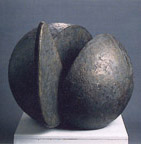
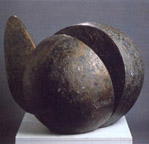 Growth Form, 1962 Figs. 86a, b is composed with interests such as these in mind; indeed,in many respects it marks a significant departure from the images mentioned above and from the figurative compositions which dominate the early years of his development. A spherical form has been split into two segments; although they are connected towards the bottom, they are separated to accommodate space between them. In this intervening gap is inserted a wedge-shaped form which rises into the air steeply and is tilted away from the alignment of the two segments. The entire composition sits directly on the floor.
Growth Form, 1962 Figs. 86a, b is composed with interests such as these in mind; indeed,in many respects it marks a significant departure from the images mentioned above and from the figurative compositions which dominate the early years of his development. A spherical form has been split into two segments; although they are connected towards the bottom, they are separated to accommodate space between them. In this intervening gap is inserted a wedge-shaped form which rises into the air steeply and is tilted away from the alignment of the two segments. The entire composition sits directly on the floor.
It can be viewed as an entity bursting or opening to enable the birth and emergence of a new existence, which is beginning to exert its autonomy or separateness, Such a reading arises from associating suggestions springing from the title with evocations from the arrangement of the interlocking components. The composition is executed confidently and with clearly wrought purpose. It is the outcome of reconsidering the foundational notions and values of sculpture in Singapore; in this regard it is a production with radical implications.
Growth Form can be claimed to be one of the earliest non-representational sculptures produced in Singapore, although it is not the only one created by Eng Teng during this phase of his practice; it is non-representational in the sense that it is not concerned with the human figure which is the dominant interest of those who produce sculpture here. However, its radicality is not determined merely by this designation; there are deeper issues. Sculpture in its most pervasive manifestation assumes the condition of a monolith; a sculpted form appears and appeals as a compact body of mass and volume in space- It stakes its presence as a self-contained whole by its weight, stability and by securing a privileged ground. Eng Teng alters or interrogates these premises; or, and to say it differently, in Growth Form he examines these premises and explores alternative ways of producing and viewing sculpture. The most significant innovations in his practice and in the story of sculptural activity in Singapore are to be seen in the treatment of the monolith and the elimination or omission of the base.
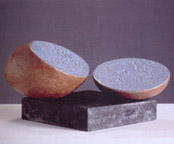 The monolith is by no means the defining condition of sculpture in a remote past; in the hands of Brancusi at the beginning of this century it gained fresh formal relevance and novel symbolic force. By means of single-minded concentration on mass and volume, Brancusi created compact forms of rigorous simplicity, whose appeal was universal and unrivalled. His approach and works established a tradition in modern sculpture; Eng Teng would have encountered Brancusi in publications on sculpture which were indispensable in furnishing resources for his development. Indeed, in disclosing his esteem for Brancusi, Eng Teng singles out "concentration and simplicity" as the abiding attributes for his consideration. And there are productions in which the notion of sculpture in its embryonic form, or as Eduard Trier describes this approach as leading to the creation of "kernel sculpture", is powerfully realised., (Trier, p. 12.) Two Forms (Fig. 71), which was discussed in the preceding chapter, vividly displays Eng Teng's absorption of this conception of sculpture; each of the two formal components is compact, solid, shut in on all sides and self-contained.
The monolith is by no means the defining condition of sculpture in a remote past; in the hands of Brancusi at the beginning of this century it gained fresh formal relevance and novel symbolic force. By means of single-minded concentration on mass and volume, Brancusi created compact forms of rigorous simplicity, whose appeal was universal and unrivalled. His approach and works established a tradition in modern sculpture; Eng Teng would have encountered Brancusi in publications on sculpture which were indispensable in furnishing resources for his development. Indeed, in disclosing his esteem for Brancusi, Eng Teng singles out "concentration and simplicity" as the abiding attributes for his consideration. And there are productions in which the notion of sculpture in its embryonic form, or as Eduard Trier describes this approach as leading to the creation of "kernel sculpture", is powerfully realised., (Trier, p. 12.) Two Forms (Fig. 71), which was discussed in the preceding chapter, vividly displays Eng Teng's absorption of this conception of sculpture; each of the two formal components is compact, solid, shut in on all sides and self-contained.
In Growth Form, on the other hand, the solid volume has been opened up; the selfcontained monolith has given way to a composition made up of the aggregate of formal units and properties. What is more, sculpture is no longer characterised only by solidity, only by an enclosed body of mass and volume, but by the interlocking or interpenetration of a number of elements. Growth Form embodies solid and space, mass and void, and outer and inner volume. Simplicity has been replaced by complexity; self-containment is substituted with an ordering of components in which some are dominant and others subordinate. By opening the compact form, space enters into the configuration and assumes a positive, integral role in the design of the work. The intervening space acts as a bridge connecting the two spherical components; it also produces a variety of cast shadows, illuminating and darkening the outer and interior surfaces in shifting intensity. The insertion of the wedge-shaped form generates complexities; for instance, the curvaceous contours of the spherical components are disrupted. The vertical thrust of this form counters, even competes with, the stability evoked by the rounded forms. The sense of homogeneity, which would have prevailed if the monolith had been safeguarded, is compromised; in its stead appear shapes which vie for attention and arrangements consisting of jostling units. These interests, even as they are different or separate, do not evoke disquiet or point to agitated situations; on the contrary, the individual components are carefully controlled; their relationships are measured. Growth Form conveys settled presences.
At the beginning of the discussion of this composition I remarked that Growth Form breaks new ground in sculptural practice in Singapore by breaching two foundational premises distinguishing sculpture as an art medium. The first has to do with the monolith and it has been dealt with; the second is directed towards the base or, more precisely, its elimination. The base is a convention by which a sculpted image secures a ground amidst the surrounding reality and is firmly Tooted in it; it is also a device by which the sculpted image is segregated from its environment. Oddly, it is this dual aspect which projects the image as having an existence and a presence of its own. Jack Burnham underscores the primacy of the base when he observes that it "helps to create an aura of distance and dignity around the favoured object."11
Throughout the twentieth century, artists have relooked at and rethought the function of the base; a number of strategies were initiated to invest it with new values or to eliminate it altogether. There also emerged yearnings to free sculpture from the confines of gravity and set it air-borne. These endeavours widened the scope for sculptural activity immensely and, at times, resulted in the submission of bewildering productions for consideration as sculpture; these endeavours also severely tested and "undermined the protocol of the viewer-object relationship."(Burnham, p. 43.) So much so that in reviewing the condition of sculpture in 1964, Herbert Read was forced into adopting a dispirited stance and expressed his view in the following way:
One must ask a devastating question: to what extent does the art remain in any traditional (semantic) sense sculpture? From its inception in pre-historic times down through the ages until comparatively recently sculpture was conceived as an art of solid form, of mass, and its virtues related to spatial occupancy.(Read, p. 250.)
The sculpture that was produced after World War II struck Read as having abandoned these goals; for him, the art was reduced to nothing more that "a scribble in the air "(Ibid.) If questioning the definition of an art medium was debilitating for Read in the mid 1960s, it is now the norm; interrogation is intrinsic to any discourse. Of course Read's vision is fuelled by an ideal view of art, one which strenuously rejects the contamination of art by extraneous forces such as technology, popular culture, concepts and ideas emerging from diverse lived experiences. Not everyone subscribes to such a vision.
By eliminating the base and placing Growth Form directly on the floor, Eng Teng induces a pronounced degree of casualness in the relationship between the object and the viewer. In siting it on the floor, the earlier obligation to position the sculpted image at the standing eye-level of the viewer is by-passed. An immediate consequence is to bring the work closer to the flux of life and dismantle the hierarchical ordering of its presence. The viewer can forge direct connections with the object without observing the norms of propriety. Whereas in the sculpted figure perched on a pedestal of base the spectator-image association is governed by conventions of presentation and seeing, in the case of the object placed on the floor, such patterns can be cast aside. Fixed modes are replaced by fluid relations, and even happenstance.
In all these respects Growth Form establishes an important milestone in Eng Teng's artistic development as well as in the history of sculpture in Singapore. Eng Teng seized upon them as arenas that can be prospected. He did so with the aim of varying the, presentational aspects of sculpture, constantly reconsidering the parameters for viewer-figure interconnections. He did so in order to extend, tender flexible the boundaries of sculpture, so that the art of projecting bodies in space is imbued with fresh purpose and meaning.
I have dwelt at length on Growth Form because of its innovative status; in teasing out some of its novel features and sketching their implications, the criteria for considering works produced along comparable lines have been established, thereby facilitating their discussion. In dealing with this production at such length and in enlarging the terrain for its interpretation, it might be construed that Eng Teng's sculptural intentions are framed by the consequences teased from this work; the impression may be gained that his aims are directed chiefly towards substituting traditional values with new or alternative ones. This is not the case. In this connection it has been remarked that Eng Teng's practice is characterised by a plurality of approaches and engagements. His versatility surfaced at the very beginning and has persisted throughout his artistic development until the present; it is an attribute encompassing a variety of media and processes, as well as concepts and presentational aspects.
 The earliest sculptural productions in this collection demonstrate Eng Teng's attempts at gaining familiarity with the language of modern sculpture; he does so by turning to a number of sources, examining them carefully, adapting and incorporating them into his scheme of creativity. Even as these are exploratory, and in some instances tentative, they embody the ideals articulated by Herbert Read, namely: sculpture conceived as "an art of solid form, of mass, and its virtues related to spatial occupancy." In Sorrow, c.1959 (Fig. 87) his reading of Rodin's use of the partial figure for intense dramatic purposes is acute and deep. The limbless, bust-length female figure strains as if seeking to release itself from a state of entrapment; it is a conception of struggle which features prominently in his figurative compositions. The head is tilted; the eyes are wide open while the mouth is parted, gasping for air. The neck is stretched and elongated to an unbearable degree; the breasts slope downwards, countering and responding to the pressure imposed by the outstretched neck. The hair is swept back and discreetly coiled, revealing the heightened expressivity of the head and neck. Sorrow can be viewed as signalling Eng Teng's tribute to Rodin; in paying homage to one of the fountainheads of modern sculpture, he declares one branch of his artistic lineage.
The earliest sculptural productions in this collection demonstrate Eng Teng's attempts at gaining familiarity with the language of modern sculpture; he does so by turning to a number of sources, examining them carefully, adapting and incorporating them into his scheme of creativity. Even as these are exploratory, and in some instances tentative, they embody the ideals articulated by Herbert Read, namely: sculpture conceived as "an art of solid form, of mass, and its virtues related to spatial occupancy." In Sorrow, c.1959 (Fig. 87) his reading of Rodin's use of the partial figure for intense dramatic purposes is acute and deep. The limbless, bust-length female figure strains as if seeking to release itself from a state of entrapment; it is a conception of struggle which features prominently in his figurative compositions. The head is tilted; the eyes are wide open while the mouth is parted, gasping for air. The neck is stretched and elongated to an unbearable degree; the breasts slope downwards, countering and responding to the pressure imposed by the outstretched neck. The hair is swept back and discreetly coiled, revealing the heightened expressivity of the head and neck. Sorrow can be viewed as signalling Eng Teng's tribute to Rodin; in paying homage to one of the fountainheads of modern sculpture, he declares one branch of his artistic lineage.
 In the Head of John the Baptist, c. 1960-61 (Fig. 88) Eng Teng steps further back into the history of European art in order to register a range and depth of expressive modes; a possible source for this image are the relief carvings on French Gothic cathedrals. The Baptist is presented as a most austere man of the desert, who undergoes severe trials which test his entire being. John the Baptist is beheaded to satisfy Salome who asked for it as a reward for dancing for King Herod; it is a subject featured by a number of artists during the period of the Renaissance, the most renowned representation being the one by Donatello for the font in San Giovanni, Siena (completed in 1427). In Eng Teng's rendering, life appears frozen, terminated abruptly; the expressive resonances are forcefully inscribed and detailed. The mouth is gaping; the eyes are askew and drilled open. The skin on the checks and forehead is deeply furrowed and drained of all vitality. The expressive tenor is vividly registered on the surface; the treatment of the medium, however, is clumsy. Eng Teng employs a thick layer of clay, not as yet grasping the malleable, tensile properties of this material; in part this is the outcome of having to milise a crude variety of clay used primarily for the manufacture of bricks from the Alexandra Brickworks. In part this is a consequence of self-learning, of a procedure entailing trial-and-error, and not having the benefit of formal or systematic instruction.
In the Head of John the Baptist, c. 1960-61 (Fig. 88) Eng Teng steps further back into the history of European art in order to register a range and depth of expressive modes; a possible source for this image are the relief carvings on French Gothic cathedrals. The Baptist is presented as a most austere man of the desert, who undergoes severe trials which test his entire being. John the Baptist is beheaded to satisfy Salome who asked for it as a reward for dancing for King Herod; it is a subject featured by a number of artists during the period of the Renaissance, the most renowned representation being the one by Donatello for the font in San Giovanni, Siena (completed in 1427). In Eng Teng's rendering, life appears frozen, terminated abruptly; the expressive resonances are forcefully inscribed and detailed. The mouth is gaping; the eyes are askew and drilled open. The skin on the checks and forehead is deeply furrowed and drained of all vitality. The expressive tenor is vividly registered on the surface; the treatment of the medium, however, is clumsy. Eng Teng employs a thick layer of clay, not as yet grasping the malleable, tensile properties of this material; in part this is the outcome of having to milise a crude variety of clay used primarily for the manufacture of bricks from the Alexandra Brickworks. In part this is a consequence of self-learning, of a procedure entailing trial-and-error, and not having the benefit of formal or systematic instruction.
It was during his pupilage at Stoke-on-Trent and Farnham that Eng Teng gained knowledge of clay as a medium, and facility in employing it for industrial as well as artistic purposes. Even though his technical abilities were limited before this phase, it did not inhibit him from dealing with it. Through persistence and close study of precedents, he assembled a modest range of formal entities to suit his purpose, This is clearly seen in Singapore Girl which was discussed in Chapter I and illustrated as Fig. 9. As in Head of John the Baptist, this work is also marked by an awkward treatment of clay, and for similar reasons. Yet, the formal devices alleviate deficiencies emerging from inadequate handling of the material. Singapore Girl demonstrates affinities with Lim Nan Seng's compositions; this is especially evident in the drapery of the figure and in the modelling of the torso and head. Among the most prominent devices is the use of coiled and overlapping surfaces to evoke continuous flows of drapery folds; Eng Teng has grasped the potency of this device and has used it advantageously, intelligently. Nan Seng attained a pronounced degree of naturalism in his figurative compositions; this was realised by employing modulated planes which softly settled into assuming figurative forms; his figures appear to be vitalised by an inner force or inner life. The torso of Singapore Girl with its undulating surfaces and the smiling face comes close to embodying the values highlighted in Nan Seng's works.
One influence towers over all others in shaping the early phase of Eng Teng's sculptural practice; it can be traced to Jean Bullock. This is hardly surprising for it was she who provided him with the foundational knowledge of sculpture and introduced new materials for his consideration. Eng Teng met her through the agency of the British Council; they became firm friends. He describes the occasion vividly:
In 1959 1 had the good fortune to meet Jean Bullock who arrived with her British air force husband, John. Through the British Council, Jean approached to meet local artists who spoke English. Chia Yew Kay of the British Council introduced Jean Bullock to me. We became good friends. I used to get my nieces to pose and we worked together on developing sculptures featuring the head. I was learning and she was teaching me the finer aspects of sculpture making, I also helped her cast her works in ciment fondu concrete and in the process began to understand the material. I learnt a lot from her and consider her my teacher. If not for her I would not have been working in ciment fondu. I find ciment fondu a great material for sculpture, although it is industrial concrete and this puts people off it. (Conversation, p. 152.)
 It was a mutually enhancing relationship and has endured until the present. Eng Teng identifies her as his teacher, emphatically; indeed, she was his only teacher in sculpture. He did not receive instruction from anyone else or from any other source. When lie enrolled in Farnham School of Art he declared his interest in sculptural studies and produced three-dimensional work while residing there; the supervision, however, was haphazard and ineffectual. Besides learning from her, Eng Teng and Bullock produced sculpture as fellow-artists; to this end, he enlisted his nieces to pose as models. The interest was in the head as an autonomous subject and an independent formal entity; in this regard the camaraderie between them was crystallised by the creation of portrait heads of one by the other (Fig. 90 [only sculpture of Jean Bullock by Ng Eng Teng shown]). Eng Teng also collaborated in projects initiated by Bullock and assisted in completing them; in this way he became familiar with ciment fondu which has remained as the preferred material for his sculptural productions.
It was a mutually enhancing relationship and has endured until the present. Eng Teng identifies her as his teacher, emphatically; indeed, she was his only teacher in sculpture. He did not receive instruction from anyone else or from any other source. When lie enrolled in Farnham School of Art he declared his interest in sculptural studies and produced three-dimensional work while residing there; the supervision, however, was haphazard and ineffectual. Besides learning from her, Eng Teng and Bullock produced sculpture as fellow-artists; to this end, he enlisted his nieces to pose as models. The interest was in the head as an autonomous subject and an independent formal entity; in this regard the camaraderie between them was crystallised by the creation of portrait heads of one by the other (Fig. 90 [only sculpture of Jean Bullock by Ng Eng Teng shown]). Eng Teng also collaborated in projects initiated by Bullock and assisted in completing them; in this way he became familiar with ciment fondu which has remained as the preferred material for his sculptural productions.
Bullock's influence on Eng Teng was transmitted by means of demonstrations; that is to say, teaching was conducted by extending her practice, by making Sculpture not in the privacy of the studio but in the open and in the presence of another. Such performative events are powerful means of conveying intentions and methods; and they endure. Eng Teng absorbed the objectives and procedures that he beheld. The aims of Bullock's instruction were twofold, namely: (a) to gain familiarity with materials, probing into their constitution and manipulative range or propensities; (b) to cultivate comprehensive knowledge of formal construction. The subject was the human figure with an emphasis on the head.
A graduate of Watford College of Art and Camberwell College of Art in London, Jean Bullock was an accomplished portrait sell plot at the time she arrived in Singapore, Her compositions are modest in size and even unprepossessing. On closer scrutiny, however, acuity of observation springs into relief and the detailed registration of expressive states or situations gain in intensity. She has produced a range of figurines and a substantial body of work featuring the head; the preference for the head is not unusual. The head is conceived as the confluence of the most complex psychological and physiological features that distinguish human beings; it is for this reason that it has assumed the status of a sovereign entity, especially in European art traditions, Even as it has an illustrious tradition, the interest in the head has not diminished; indeed, it has attained wide appeal amongst modern/ contemporary artists practicing in greatly differing cultural conditions, There is an additional factor to be considered; the autonomy of the head has been secured at the expense of the remainder of the body. This can be turned to advantage in those circumstances in which the representation of the body is regarded with anxiety and trepidation, Although Eng Teng is aware of such circumstances, he is not necessarily constrained by them.
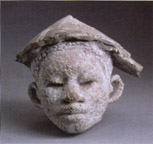 In this collection there is a head, a remnant of a three-quarter length figure, which can be attributed to the phase when he was learning from and with Jean Bullock, Head of Paddy Boy, c. 1959 (Fig. 92); it is the only surviving work featuring the head executed at this time. The surface is untreated; the scum from the plaster of paris mould remains uncleaned. The main interest is in the modelling of the face, and the outcome is uneven; the ears and the nose are treated clumsily with inadequate comprehension of proportion and relationship. The eyes and the forehead, on the other hand, demonstrate sensitivity to formal arrangements and emotional resonances. The eyelids droop gently and curve over the eye; the forehead rises steeply, directly over the eyes and eyebrows, and then slopes gradually towards the hairline in a curving plane. Approached with emotional or psychological interests these details provoke thoughts on the fragile state of the young, and tile vulnerability of youth.
In this collection there is a head, a remnant of a three-quarter length figure, which can be attributed to the phase when he was learning from and with Jean Bullock, Head of Paddy Boy, c. 1959 (Fig. 92); it is the only surviving work featuring the head executed at this time. The surface is untreated; the scum from the plaster of paris mould remains uncleaned. The main interest is in the modelling of the face, and the outcome is uneven; the ears and the nose are treated clumsily with inadequate comprehension of proportion and relationship. The eyes and the forehead, on the other hand, demonstrate sensitivity to formal arrangements and emotional resonances. The eyelids droop gently and curve over the eye; the forehead rises steeply, directly over the eyes and eyebrows, and then slopes gradually towards the hairline in a curving plane. Approached with emotional or psychological interests these details provoke thoughts on the fragile state of the young, and tile vulnerability of youth.
 Hock Tin, 1961 (Fig. 93), exemplifies formidable accomplishment in composing the head; in this work the influence of Bullock is apparent (see Fig. 89). The influence has also been absorbed and internalised, so much so that the image projects confidence and purpose as well as familiarity with the method of composition. This head can be viewed comparatively with his painted portraits of members of his family; as in them, here too Eng Teng deals with complexities arising from, familiarity (Hock Tin is his niece) and the need to maintain 6istance in Order to portray an image of another. The cheeks, chin and neck are modelled sensitively; the mouth is forcefully shaped with the lips curled and outlined clearly. The hair settles as a compact covering on the skull, is, wrapped over the sides and partially over the ears. The neck flares outwards indicating the shoulders and in this manner, reaches out into space; while the image is rooted in its base, it also is connected with its environment.
Hock Tin, 1961 (Fig. 93), exemplifies formidable accomplishment in composing the head; in this work the influence of Bullock is apparent (see Fig. 89). The influence has also been absorbed and internalised, so much so that the image projects confidence and purpose as well as familiarity with the method of composition. This head can be viewed comparatively with his painted portraits of members of his family; as in them, here too Eng Teng deals with complexities arising from, familiarity (Hock Tin is his niece) and the need to maintain 6istance in Order to portray an image of another. The cheeks, chin and neck are modelled sensitively; the mouth is forcefully shaped with the lips curled and outlined clearly. The hair settles as a compact covering on the skull, is, wrapped over the sides and partially over the ears. The neck flares outwards indicating the shoulders and in this manner, reaches out into space; while the image is rooted in its base, it also is connected with its environment.
In utilising ciment fondu, Eng Teng employs the method of modelling; it is a process which the material is given form and shape by gradual addition. The connection between the hand and the material is direct, persistent and consequential. Of course decisions can be made to brush or mute these marks so that they assume discreet registrations rather than leave ostensive imprints. In this work, as in all others in which ciment fondu is employed, Eng Teng prefers to smoothen the surface; he is, however, alive to the effects of textural variations and the drarnatic importance of light and shade. These are manifest in Hock Tin: the planes defining the cheeks are modulated so that shadows are cast on neighbouring surfaces while light is caught by surfaces meeting and softly rising into the air. The nose ridge and indented upper lip converge into a complex formation; here modelling takes on a characteristic and powerful function. These features are formed by thrusting, accumulated forces swelling outwards from the interior. In conveying such sensibilities Eng Teng has grasped the strength and form-giving proclivity of modelling.16 Cast shadows enliven the surfaces on the forehead and cheeks, emitting the sensation of life-forces stirring beneath and impinging upon the outer skin. The neck is dipped in shadow, emerging as a pillar, its volume rounded and firm, with immense strength to support the head and to hold it in a steadfast posture. In all these aspects Eng Teng displays his ability to deal with the conventions shaping the formal and psychological dimensions of portrait heads in sculpture.
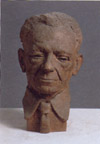
 In George, 1963 (Fig. 94), Eng Teng takes pains in detailing the appearance of the subject; this portrait head was produced while he was studying in Farnham School of Art. It is apparent that his involvement with life-drawing in this institution, which instilled in him the capacity to realise the figure as a concrete, tangible entity in formal terms, has affected his sculptural practice.In George The acuity of seeing, characteristised by registrations of detail, is transferred into sculptural form. Indeed, George can be compared with Rev. W. Short of Croydon (Fig. 78); the two portraits are distinguished by the sustained interest in physiological details as symbolising personality or a sense of psychological being.
In George, 1963 (Fig. 94), Eng Teng takes pains in detailing the appearance of the subject; this portrait head was produced while he was studying in Farnham School of Art. It is apparent that his involvement with life-drawing in this institution, which instilled in him the capacity to realise the figure as a concrete, tangible entity in formal terms, has affected his sculptural practice.In George The acuity of seeing, characteristised by registrations of detail, is transferred into sculptural form. Indeed, George can be compared with Rev. W. Short of Croydon (Fig. 78); the two portraits are distinguished by the sustained interest in physiological details as symbolising personality or a sense of psychological being.
Eng Teng pinches, gouges, depresses and raises the clay in order to shape the features and imbue them with individuality and a eyes are deep-set and quietly watchful; the mouth is settlec the upper lip gripping the lower and together inscribing a thin, curving line. The cheeks are pitted and wrinkled; the eyelids are folded heavily while the eyebrows are marked by incised furrows. The variegated surfaces which define the face are contrasted with the smoothened planes of the gently sloping forehead; these meet with the receding hair which is arranged in a compact mass. The collar and tie are forcefully designed and raised in high relief. Eng Teng manipulates clay effectively and purposefully; the features are studied closely and have been sensitively transformed through the medium to present an image of a person captured at a particular moment. The insistence on particularity leads Eng Teng away from idealised projections to deep considerations of the nature of specific bodies in specific time and space.
These are not momentary or contingent preoccupations. Of course facilities acquired between 1959-1964 attain maturity and are diversified in the 1970s; there also is an expansion of themes and a widening of symbolic interests over the years. Even so, and this has already been observed on a few occasions, concepts or compositions marking significant phases in his development resurface in subsequent years. When they do, at times the formal aspects are transformed only in detail while the scope of the content is deepened and intensified; at other times the recollection of earlier efforts provokes new, surprising departures, resulting in innovative productions. The head as a theme recurs periodically, and embodies a variety of formal and symbolic schemes. For the moment one such work is considered.
 Ten years after he produced George, Eng Teng executed a portrait head each of his father and mother; Portrait Head of Mother, 1973 (Fig. 95) is in this collection while that of the father is with the artist. As with the image of George, here too there appear detailed depictions of physical features highlighting the outcome of ageing. The thinning hair is pulled tightly over the skull, and rendered as raised, uneven bands. The cheeks and forehead are wrinkled; the skin is in some sectors folded and sagging, and furrowed and shrunken in other sectors. Eng Teng has painstakingly inscribed the surface with a range of marks produced by varying the pressure applied by his hands on the material; the malleable nature of clay and ciment fondu permit the transfer of form-making from one to another effectively. Light skims over the surface, settling into pools of shadow in recesses and glinting when it catches a protruding surface; cast shadows and highlights evoke planes turning in space, thereby pointing to three-dimensional attributes or forms. Whereas George is cast with a severe demeanour, in portraying his mother, while maintaining a distance allowing him to observe and represent details of appearance scrupulously, Eng Teng also infuses the image with warmth and gentleness. Portrait Head of Mother imparts a contained, reflective presence.
Ten years after he produced George, Eng Teng executed a portrait head each of his father and mother; Portrait Head of Mother, 1973 (Fig. 95) is in this collection while that of the father is with the artist. As with the image of George, here too there appear detailed depictions of physical features highlighting the outcome of ageing. The thinning hair is pulled tightly over the skull, and rendered as raised, uneven bands. The cheeks and forehead are wrinkled; the skin is in some sectors folded and sagging, and furrowed and shrunken in other sectors. Eng Teng has painstakingly inscribed the surface with a range of marks produced by varying the pressure applied by his hands on the material; the malleable nature of clay and ciment fondu permit the transfer of form-making from one to another effectively. Light skims over the surface, settling into pools of shadow in recesses and glinting when it catches a protruding surface; cast shadows and highlights evoke planes turning in space, thereby pointing to three-dimensional attributes or forms. Whereas George is cast with a severe demeanour, in portraying his mother, while maintaining a distance allowing him to observe and represent details of appearance scrupulously, Eng Teng also infuses the image with warmth and gentleness. Portrait Head of Mother imparts a contained, reflective presence.
The importance of the human figure in Eng Teng's thoughts and art is not in dispute, and it will be discussed shortly; from the onset and throughout the advancement of his sculptural practice until the present, the figure constitutes a primary theme. Although it is pre-eminent, it is not an exclusive preoccupation. He leaves the figure and develops forms that are invented; he creates hybrid configurations by fusing components derived from human, geometric and organic sources.
These imaginary formations extend the field of iconography in the practice of sculpture in Singapore; in this connection Eng Teng has, more than any other sculptor, widened the scope of formal invention and symbolic expression. The variety of shapes and forms that he has created is unrivalled; the symbolic dimensions he develops are unmatched in complexity. The term iconography needs a little explanation as it may lead one to expect the demonstration of shared symbolic worlds through the dramatisation of myths and legends and the declaration of religious beliefs. For the most part the iconography in Eng Teng's sculpted world is privately determined. In this sense, iconography does not imply schemes or programmes prescribed by authority or any empowered agency; it is to be understood as a vital area or domain of creative invention, whereby new entities are produced which convey new meanings. As these originate front the imagination and personal vision of the artist, they can be grasped only with considerable effort and indirectly or intuitively.
 Responsibility I, c. 1960 (Fig. 96) and Squeeze (Fig. 97) are symptoms of these aims; they are exploratory, and approached in this spirit are seen as provocative and challenging. Conceptually and formally they breach the boundaries of sculptural thinking and making, assuming considerable liberties in the degrees to which representationality is transformed and almost abandoned. In these respects they mark milestones which remained unappreciated and, in all probability, incomprehensible at the time of their production.
Responsibility I, c. 1960 (Fig. 96) and Squeeze (Fig. 97) are symptoms of these aims; they are exploratory, and approached in this spirit are seen as provocative and challenging. Conceptually and formally they breach the boundaries of sculptural thinking and making, assuming considerable liberties in the degrees to which representationality is transformed and almost abandoned. In these respects they mark milestones which remained unappreciated and, in all probability, incomprehensible at the time of their production.
 The first and immediate impact is the audacious treatment of the material; ciment fondu is pressed into assuming fluid characteristics as it is made to twist and turn, expand and contract, responding to the demands of the manipulating hands without resistance, and pliantly. Rarely, if ever, does Eng Teng employ this material with such abandon, yielding to intense improvisational approaches. And the outcome is compelling. In Responsibility I, the composition commences with an irregular cylindrical form whose surface is coiled; the threads of the coil are uneven as the raised body is irregular. As the cylinder ascends, it expands outwards into a writhing, amorphous mass which is crowned by a miniature head, whose features are abbreviated.
The first and immediate impact is the audacious treatment of the material; ciment fondu is pressed into assuming fluid characteristics as it is made to twist and turn, expand and contract, responding to the demands of the manipulating hands without resistance, and pliantly. Rarely, if ever, does Eng Teng employ this material with such abandon, yielding to intense improvisational approaches. And the outcome is compelling. In Responsibility I, the composition commences with an irregular cylindrical form whose surface is coiled; the threads of the coil are uneven as the raised body is irregular. As the cylinder ascends, it expands outwards into a writhing, amorphous mass which is crowned by a miniature head, whose features are abbreviated.
This is a dynamic composition, although it is not consistent; in it there are passages which are cluttered. The lower component can be interpreted as a spiral, a universal device denoting unending motion, having neither beginning nor ending. As it ascends the spiral expands; its material dimensions come into view forcefully. The velocity of movement affects the material body, pulling and pushing it from all directions, thereby deforming it. In the midst of this maelstrom there appears an element which acts as a steadying, calming centre; the head is the axis of the entire configuration and it manages to signal an alert, commanding presence. Taking the cue from the title, responsibility can be understood as an unending, gargantuan obligation which knows no bounds; yet, to fulfill it, a semblance of proportion or scale has to be gained, and for this detachment has to be exercised.
Squeeze shares compositional features with Responsibility I; contrasted with the compact, although volatile mass surmounting the coiled cylinder in the latter, in Squeeze the culminating component is highly articulated. The spiralling movement threatens to disintegrate the material body as tongue-like elements flick out into space and are ceaselessly undulating; some of them curl back on themselves while others remain extended and tremble as a consequence. The notion of sculpture as a stable, neatly contoured monolithic entity is considerably altered; instead of connected surfaces that define and secure three-dimensional properties, this work is enlivened by disjointed, erratic formal units which destabilise the environment. The environment is agitated as it responds to the pulls and pushes of the elastic formation; space no longer can envelop the form as a neatly-fitting glove but lodges in irregular recesses, curves around quirky shapes and quivers along ill-defined paths. The imagery evokes a sense of matter settling and assuming semblance of form by chance, and momentarily.
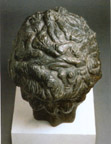 The formal constitution of these two works are undoubtedly unique; but they are not singular. For instance in Tragedy of War II, 1967 (Fig. 98) a similar combination of vertical and rounded elements are employed to describe the cloud formation ensuing from the detonation of a nuclear bomb. At first viewing, the image appears as a literal illustration of the famed mushroom-cloud shape publicised in the mass media and popular films. It is that and a little more. Closer inspection reveals tiny formations or rather deformations that appear creature-like, writhing in agony. The dome-like formation whose surface is intricately articulated, and seen to be supporting slithering life-forms, can be cited as an originating source for compositions featuring figures clinging to spherical forms that are placed on the floor and allowed to rock and swivel.
The formal constitution of these two works are undoubtedly unique; but they are not singular. For instance in Tragedy of War II, 1967 (Fig. 98) a similar combination of vertical and rounded elements are employed to describe the cloud formation ensuing from the detonation of a nuclear bomb. At first viewing, the image appears as a literal illustration of the famed mushroom-cloud shape publicised in the mass media and popular films. It is that and a little more. Closer inspection reveals tiny formations or rather deformations that appear creature-like, writhing in agony. The dome-like formation whose surface is intricately articulated, and seen to be supporting slithering life-forms, can be cited as an originating source for compositions featuring figures clinging to spherical forms that are placed on the floor and allowed to rock and swivel.
Earlier, mention was made of the human figure and its importance was underlined. An overview of this collection, including paintings and drawings, will reinforce its prominence. In his sculptural work, the figure enables Eng Teng to demonstrate his involvements with a wide range of social and political issues; the figure is also a vivid, palpable means to embody different emotional, psychological states or situations. From this, it maybe gathered that the approach to the figure is varied; and this is the case. There are compositions in which the figure asserts its pressure and appearance overtly; in them Eng Teng displays his knowledge of the conventions of modern sculpture as a tradition, both at the conceptual and formal levels; there are compositions in which the figure is subjected to radical mutations and, subsequently, new figurations emerge. Often these feature arrangements in which parts of the anatomy are abbreviated or omitted, while other parts are amplified; at times the figurations are made up by recombining anatomical parts, imbuing them with unaccustomed functions and in these ways they assume surprising, witty, even ominous presences. In the context of figurative sculpture in Singapore, Eng Teng has inaugurated an entirely novel domain of iconography; not surprisingly writers are corralled by the magnetism of these creations, and devote their commentaries to explicating their form and meaning.
 Thy Name is Woman I and II, c. 1967 (Figs. 99, 100) can be seen as works dealing with woman in primordial states of being. In the world as defined by logos, being is revealed by the word and specified by the act of naming; hence the title - Thy Name is Woman. In the world made manifest by mythos, being is made palpable and visible by, amongst other means, the fabrication or formation of material, In Thy Name is Woman I, the figure is stirring from an inert state to an active one; the right leg is flexed while the left is slightly bent, giving rise to movements that animate the rest of the figure.
Thy Name is Woman I and II, c. 1967 (Figs. 99, 100) can be seen as works dealing with woman in primordial states of being. In the world as defined by logos, being is revealed by the word and specified by the act of naming; hence the title - Thy Name is Woman. In the world made manifest by mythos, being is made palpable and visible by, amongst other means, the fabrication or formation of material, In Thy Name is Woman I, the figure is stirring from an inert state to an active one; the right leg is flexed while the left is slightly bent, giving rise to movements that animate the rest of the figure.
 Relief sculpture (as is this composition) is a dominant method of execution in sculpture; there are various kinds, and they all are attached to or set against a background support, the most prevalent being walls of buildings or architectural structures. Modern sculptors produce reliefs that are portable like paintings; and like paintings, they have no specific relationship to the places where they happen to hang. The primary appreciation of relief in sculpture stems from encountering a design or composition that is projected from a flat surface (ground) into a limited depth of space; such a design remains attached to the Surface. The depth of projection determines the height or shallowness of the forms, leading to the general distinction between high and low relief. This account may prompt connecting painting and relief sculpture for the reason that both deal with the relationship of figures to flat grounds; this connection can be Pursued only with the understanding that in relief sculpture, the projection of figures from the surface into depth in space is actual, whereas in painting it is illusory.
Relief sculpture (as is this composition) is a dominant method of execution in sculpture; there are various kinds, and they all are attached to or set against a background support, the most prevalent being walls of buildings or architectural structures. Modern sculptors produce reliefs that are portable like paintings; and like paintings, they have no specific relationship to the places where they happen to hang. The primary appreciation of relief in sculpture stems from encountering a design or composition that is projected from a flat surface (ground) into a limited depth of space; such a design remains attached to the Surface. The depth of projection determines the height or shallowness of the forms, leading to the general distinction between high and low relief. This account may prompt connecting painting and relief sculpture for the reason that both deal with the relationship of figures to flat grounds; this connection can be Pursued only with the understanding that in relief sculpture, the projection of figures from the surface into depth in space is actual, whereas in painting it is illusory.
Thy Name is Woman I is carved in low relief. While the head, torso and limbs are presented with conviction, the rendering of the upraised right arm is reduced to a generalised formal unit with unclear functions. The surface is marked by raised and sunken lines; these are grouped to generate varied rhythms simulating an agitated ground. The stirring of the figure, shifting away from a dormant state to a wakeful, assertive being is captured in some detail, The surface around the head supports a varied cluster of marks, corresponding to ripples generated by the movement of the head and arms; the figure emerges from an embryonic ground.
In Thy Name is Woman II the figure is seated; while the torso, upper and most of the lower limbs are in low relief, the head and right foot are in high relief. So much so that they extend beyond the perimeter of the relief surface and into actual space. This is a dramatic device employed to register the degree to which the figure is asserting a presence in space and, therefore, the extent to which it is consolidating a sense of being. The left arm is barely perceptible as it is largely enmeshed in the ground; the relief notation is gradually raised in the formation of the thigh, It is raised even further and expanded as the breasts, abdomen and right thigh come into view. In scanning this sector, the appreciation of surface and depth relationship defining the inner full and outer adjacent void volumes is enriched; these attributes lie at the root of sculptural thinking and, not surprisingly, are of crucial importance for Eng Teng in advancing his practice.
Thy Name is Woman I is presented for viewing as a picture; the other appears as a niche in a wall. The presentation strategies conform to the way relief compositions are to be seen and interpreted. In Thy Name is Woman II, Eng Teng breaches the function of the frame as marking the boundary of the composition; in extending the head and right foot into actual space, the image is linked to the environment directly, palpably, By making the connection tangible, the art work is inserted into common or shared space, appearing among other objects and entities, although retaining its distinctiveness. The implications surfacing from schemes such as these are germane to understanding the aims of presentation developed by Eng Tong.
 Although produced two years later, Maxi, 1969 (Fig. 101) can be regarded as generically linked to the nude female figures in Thy Name is Woman I and II. As in the earlier compositions, Eng Teng sets aside the canons of proportion in order to heighten expressivity and dramatise viewing. In Maxi the head and upper limbs are reduced in size while the abdomen and upper thighs are amplified; these very same characteristics are visible in the earlier works. Maxi represents the setting free of the figure and it is seen striding in space, away from any attachment or encumbrance. And it is precisely to convey this sensation of walking, of walking with a mighty purpose and effect that proportions have been altered; in settling on a set of relationships, Eng Teng has turned to Giacometti and adopted that artist's scheme to suit his ends. If the image is positioned at a height above vertical eye-level, then it will loom into view in elevated space; seen at this height, the thighs bearing the weight of the body in motion will need sufficiently amplified mass in order to meet with the required function. In extending the viewing upwards, the abdomen appeals as a volume corresponding to that of the thighs. The movement tapers, curving up the s1ender arms and settling on the diminutive head which marks the conclusion of the visual trajectory.
Although produced two years later, Maxi, 1969 (Fig. 101) can be regarded as generically linked to the nude female figures in Thy Name is Woman I and II. As in the earlier compositions, Eng Teng sets aside the canons of proportion in order to heighten expressivity and dramatise viewing. In Maxi the head and upper limbs are reduced in size while the abdomen and upper thighs are amplified; these very same characteristics are visible in the earlier works. Maxi represents the setting free of the figure and it is seen striding in space, away from any attachment or encumbrance. And it is precisely to convey this sensation of walking, of walking with a mighty purpose and effect that proportions have been altered; in settling on a set of relationships, Eng Teng has turned to Giacometti and adopted that artist's scheme to suit his ends. If the image is positioned at a height above vertical eye-level, then it will loom into view in elevated space; seen at this height, the thighs bearing the weight of the body in motion will need sufficiently amplified mass in order to meet with the required function. In extending the viewing upwards, the abdomen appeals as a volume corresponding to that of the thighs. The movement tapers, curving up the s1ender arms and settling on the diminutive head which marks the conclusion of the visual trajectory.
The figure in motion is of perennial interest in sculpture; in the modern era Rodin revitalised this interest with fresh objectives, articulation and meaning. For instance, he dramatised walking and in Walking Man (1872) he propelled the figure - specifically the nude - into attaining new, powerful formal and iconographic presence. This production provoked a variety of responses; in the context of twentieth-century sculpture DuchampVillon's Torso of a Young Man (1910), Boccioni's Unique Forms of Continuity in Space (1913) and Giacometti's City Square (1948-49) amongst others, constitute a pantheon of exemplary works. They vividly demonstrate the capacity of the human figure to continue to exemplify active states, symbolising differing physical, psychological and formal ideologies. Works such as these valorise the language of modern sculpture, and are available to artists practicing in diverse circumstances, globally. And Eng Teng's composition can be connected to this lineage as well. Even as it can, the occurrence which prompted its creation is particular. The mini-skirt was the most revolutionary garment in post Second World War fashion; it coincided with the emergence of youth in the forefront of popular culture and with various strategies mounted to free women from traditional roles and modes of behaviour. With its appearance, lithe and slim physiques were declared as the new ideals for physical beauty; those who did not naturally fit into this ideal set about subjecting themselves into conforming to it. In reaction to the mini, there appeared the maxi celebrating amplitude, encircling the figure with space and camouflaging its lineaments. These contending fashion statements characterised the 1960s in Singapore as well; the media was instrumental in propagating these competing ideals which were patronised by the youth. Maxi was prompted by considerations along these lines.
Modern sculptors generally turn away from genre for content in their art; indeed, as a category genre is identified and formulated to deal with painting. Sculptors avoid depiction of scenes and events from daily life partly because of the prospect of having to deal with narrative implications requiring either relief compositions or the staging of tableaux. In part, genre was bypassed because of anxieties emanating from creeping sentimentality leading to works condemned for being too literary, for illustrating the experience of others. Even as sculptors are insistent on being in this world, of delving into life's experiences for fuelling thoughts and sensibilities, they are equally insistent on the pre-eminence of expression and the expressive. The focus is not so much on actions and feeling of the subject but those of the sculptor and on the dynamics of form-making. Yes, there is interest in the body in movement in space; yet, the body is not necessarily an embodiment of particular identities. On the contrary, the drama of the body is the drama of sculptural form. It is in this sense that Maxi, while initially prompted by Eng Teng's encounter with the subjection of the body to the dictates of fashion, is transformed into an exposition of sculptural properties. Hence, the focus is on defining inner and outer volumes, and on articulating surface and depth relationships, And the endeavour is no less deserving of attention and esteem for prospecting these formal features. Maxi has been wrested from the strains of the everyday world and formed to appeal to quiet, intimate, aesthetic contemplation. Liu Kang, in responding to the works on display in the 1970 exposition concludes that Eng Teng's principal intention is to "explore the rhythms of pure lines, contrasts between solid and void, interplay of three-dimensional forms, forthright versus accommodating nature of shapes." These are the core preoccupations of modern sculpture.

 Notwithstanding the tendencies outlined above, a handful of works in this collection can be regarded as conforming to the genre category; among these To Market, 1967 (Fig. 102) and Do We Look Down?, 1968 (Fig. 104) overtly exemplify rooting in this category. To Market, which is accompanied by a study (Fig. 103), is affiliated to subject matter in drawings and paintings produced between 1960-61. In them Eng Teng devoted considerable attention to depicting scenes of markets and of figures preparing fish, vegetables and rice.
Notwithstanding the tendencies outlined above, a handful of works in this collection can be regarded as conforming to the genre category; among these To Market, 1967 (Fig. 102) and Do We Look Down?, 1968 (Fig. 104) overtly exemplify rooting in this category. To Market, which is accompanied by a study (Fig. 103), is affiliated to subject matter in drawings and paintings produced between 1960-61. In them Eng Teng devoted considerable attention to depicting scenes of markets and of figures preparing fish, vegetables and rice.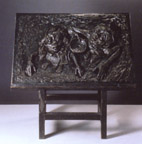 In still life compositions, the kitchen table appears replete with a similar range of edibles. Eng Teng has transferred subject matter developed for his pictures to his sculptural practice; in doing so, tensions arise in relating formal values with actions and feelings of the subject. The drawing shows an image which is settled in all particulars; the posture, the dominant shapes and details of attire, facial features and physiognomy are crystallised. Parallel lines are employed to contour voluminous forms which will ensue in converting the drawing into a three-dimensional design; in this matter, the transfer is effortless, requiring little or no change and modification.
In still life compositions, the kitchen table appears replete with a similar range of edibles. Eng Teng has transferred subject matter developed for his pictures to his sculptural practice; in doing so, tensions arise in relating formal values with actions and feelings of the subject. The drawing shows an image which is settled in all particulars; the posture, the dominant shapes and details of attire, facial features and physiognomy are crystallised. Parallel lines are employed to contour voluminous forms which will ensue in converting the drawing into a three-dimensional design; in this matter, the transfer is effortless, requiring little or no change and modification.
In the sculpted image the weight on the head is considerable and the outcome of the pressure is depicted in detail. The subject grimaces; the face is wreathed with lines of strain and the effort of the work. The neck muscles protrude in response to the strenuous effort; the arms are spindly, yet firmly hold the filled sack in place. These details, which vividly display the physical reactions of the subject, are confined to the upper portion of the body; from the torso down the interests change completely. The lower limbs are transformed into a cylindrical shape, amplified with an expansive inner volume. The surface of this section is articulated with raised lines, forming intricate geometric and floral patterns. Eng Teng has shifted his attention away from dealing with the effects of physical labour to converting the drapery of the figure into assuming complex formal sculptural considerations and decorative schemes.
Do We Look Down? does not betray any competing involvements; on the contrary, it is brutally forthright and uncompromising in describing the debilitating consequences of poverty. It is a relief composition featuring two figures severely foreshortened and presented looking upwards towards the viewer, between them is placed a begging bowl. The surface around them is marked with clusters of lines and nodules, appearing far more agitated when compared with the eddying areas surrounding Thy Name is Woman I. Eng Teng displayed this work in his first solo exhibition in 1970 and again in 1976; it did not receive any notice or mention at the time of its initial showing; in 1976, however, it drew attention and the composition was described at length. Referring to it as "expressionistic" and "Powerful" Tow Theow-Huang provides a succinct yet vivid account:
Do We Look Down? is a 1968 ciment fondu plaque installed at knee level so that we actually took down at rough and vigorously laid-down forms that project slightly from the rectangular surface. The figures are depicted in sharp "fore-shortening", so that the heads and arms seem disproportionately larger than the torsos and legs and the figures appear to peer up from a pit.
The centre of interest is a begging bowl, held by one of the figures and the emotive symbolism as well as the strong contrast between round bowl and rectangular plaque, create a powerful effect.
Tow Theow-Huang, 'Sculptures that rock and roll' in New Nation, November 26, 1976.
Earlier, mention was made of the anxieties attending the treatment of genre subjects b) modern sculptors, especially as it may lead to the ensuing works castigated for being sentimental and illustrative. Do We Look Down? veers close to that level, brushing along the alleyways of bathos. Eng Teng has devoted extensive resources in registering realism in the countenance of the figures; yet, the presentation does not point to fresh consideration of the relationship between poverty and the patronising attitudes adopted by those seeking to alleviate it. Indeed, it underscores the status quo.
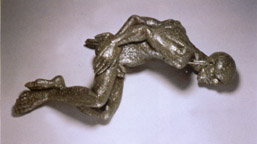 Declining Man, 1969 (Fig. 105) is one of the earliest sculptural representations of a figure in distress in this collection. An elderly male figure is presented in the nude, reclining and turned on its left side. The face is gaunt and grizzled; the body is deformed with bones knobbled, protruding and the abdomen is distended. The figure is irredeemably alone and stripped of all signs of accommodation; yet, it emits a restrained presence. This is far removed from the rhetorically surcharged atmosphere in which Do We Look Down? is posed, Declining Man is laid out on its own ground, preoccupied in its own condition and being. There is not any perceptible moral or emotional gloss overlaid. The figure is composed and articulated vigorously; patterns of rhythm emerge from relating volume with volume and with adjacent planes. For instance, the spherical form of the head corresponds with the swollen abdomen and with the curvaceous planes of the knees. The deep-set eyes draw in dark pools of shadow as does the sharply curving chest and the complex interlocking ankles. Contours are robust and varied as they enclose and define interlocking components of the wiry anatomy.
Declining Man, 1969 (Fig. 105) is one of the earliest sculptural representations of a figure in distress in this collection. An elderly male figure is presented in the nude, reclining and turned on its left side. The face is gaunt and grizzled; the body is deformed with bones knobbled, protruding and the abdomen is distended. The figure is irredeemably alone and stripped of all signs of accommodation; yet, it emits a restrained presence. This is far removed from the rhetorically surcharged atmosphere in which Do We Look Down? is posed, Declining Man is laid out on its own ground, preoccupied in its own condition and being. There is not any perceptible moral or emotional gloss overlaid. The figure is composed and articulated vigorously; patterns of rhythm emerge from relating volume with volume and with adjacent planes. For instance, the spherical form of the head corresponds with the swollen abdomen and with the curvaceous planes of the knees. The deep-set eyes draw in dark pools of shadow as does the sharply curving chest and the complex interlocking ankles. Contours are robust and varied as they enclose and define interlocking components of the wiry anatomy.
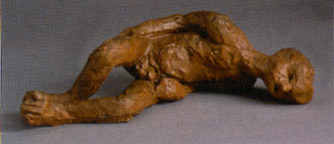 Declining Man emerged from figurative compositions developed by Eng Teng during his pupilage at Farnham School of Art (1963-64); it will be recalled that while in that institution he recommenced drawing, especially drawing the nude figure; even though his principal engagement was with studio pottery, he was also interested in expanding the foundations of his sculptural practice. Occasionally, his studies of the nude figure were transferred from the drawing surface to three-dimensional compositions. A male figure, bound hand and foot, reclining on its left side was produced while studying in Farnham; it can confidently be claimed as a precedent for Declining Man. The kinship is apparent, visible, in similarity in posture and articulation of the body ' there are differences as well, springing chiefly from iconographic destinations. The bound figure highlights a male youth, athletic, which is fettered and encumbered; it is the nucleus for subsequent figurations symbolising captivity and bondage. Declining Man on the other hand, while it also features a male figure, deals with ageing and destitution; it is also preceded by a maquette (Fig. 107). Modelled in clay, it displays the design at an initial stage and tentatively; the proportion and positioning of the lower limbs are awkward, while the left arm appears as an undistinguished lump. These gain resolution, definition and function in the final composition. Declining Man has been realised methodically and vitalised by reprising an earlier composition.
Declining Man emerged from figurative compositions developed by Eng Teng during his pupilage at Farnham School of Art (1963-64); it will be recalled that while in that institution he recommenced drawing, especially drawing the nude figure; even though his principal engagement was with studio pottery, he was also interested in expanding the foundations of his sculptural practice. Occasionally, his studies of the nude figure were transferred from the drawing surface to three-dimensional compositions. A male figure, bound hand and foot, reclining on its left side was produced while studying in Farnham; it can confidently be claimed as a precedent for Declining Man. The kinship is apparent, visible, in similarity in posture and articulation of the body ' there are differences as well, springing chiefly from iconographic destinations. The bound figure highlights a male youth, athletic, which is fettered and encumbered; it is the nucleus for subsequent figurations symbolising captivity and bondage. Declining Man on the other hand, while it also features a male figure, deals with ageing and destitution; it is also preceded by a maquette (Fig. 107). Modelled in clay, it displays the design at an initial stage and tentatively; the proportion and positioning of the lower limbs are awkward, while the left arm appears as an undistinguished lump. These gain resolution, definition and function in the final composition. Declining Man has been realised methodically and vitalised by reprising an earlier composition.
All three productions are rooted in the figure; indeed, the figure is pervasive and widely apparent, so much so that it might appear as obvious and therefore beyond the need for comment or explication. In the accounts that have been published, the figure is assumed as given and hardly any effort is made to probe into its role and significance. In this study, Eng Teng's approach to the figure has been discussed in connection with particular works or categories of works; it is clear that the figure is employed in different ways and in Order to satisfy a variety of purposes or goals. Be that as it may, can generalisations be advanced in order to point to an ideology framing the use of the figure or attitudes towards the figure? Constance Sheares underlines the primacy and omnipresence of the human figure in Eng Teng's art and thoughts:
His main source of expression has always been the human figure, and even in his abstract works are experiments based on elements of the human form. Indeed, throughout his career Ng seems to have kept two distinct styles going side by side - rounded, biomorphic forms portraying human conditions such as motherhood, or mental states such as fear; and angular or geometric forms, reminiscent of metal sheets, pipes or beams, abstractions of the human figure but often imbued with a distinct sense of burnout. (Poetic Metaphors: Sculptures by Ng Eng Teng, p. 1)
Sheares rightly observes that Eng Teng's practice is most usefully characterised in terms of plurality of involvements that converge, rather than in terms of singular, exclusive pursuits; she proceeds to consolidate these involvements by categorising two dominant "styles", and elaborates on them. What might be added to these observations is that while Eng Teng's multiple engagements, often initiated in tandem with one another, tend to converge, such convergences do not necessarily negate or evade tensions and competitive claims or operations. In this connection, the analysis of works in this study has largely been prompted by these considerations.
In seeking to appraise Eng Teng's position in a national context, Sheares seizes upon the human figure as the criteria for claiming a pre-eminent status for the artist:
In the last few years the figure in one form or another has regained a place in sculpture. With it has come a clearer sense of subject matter and an awareness that sculpture can reflect not only the immediate experience of artists but also the society in which they find themselves. Other sculptors in Singapore have sought to break new ground by using now materials or a non-objective idiom, but none has been as successful as Ng Eng Teng in expressing basic human sentiments and relationships in terms of the human figure.(Ibid., p. 4.)
Taken together, these two disclosures emphatically place the human figure at the core of Eng Teng's sculptural practice; what is more, they also highlight Eng Teng as the foremost artist using the figure to symbolise a range of personal and social issues or themes, Eng Teng has discussed the figure, readily confirming its centrality in his art and usually by hitching it to subject matter or content; not surprisingly, his accounts sketch a broad terrain of iconographic engagements. A typical description runs along the following lines:
Humanity, yes, life itself is my main inspiration. All along working on figures, human beings, the good and bad side of life, the achievements and downfall of mankind. The thought of losing life and wasting one's life is urgent in my mind. While we have life, we must treasure it. Humanity begins with the family, parents and children, their upbringing and relationships. So the mother and child theme has been very prominent in my work.
I look on the whole emotional aspects of mankind. The struggle, the heartache, the love, the barred and bitterness of life. (Conversation, p. 167.)
Occasionally he moves in close, scrutinises issues and describes his intentions in detail; "I want to express humanist themes in my work and what better way than through the human figure. The human figure best expresses feelings and ideas because it is closest to us, it is what we can relate to best." (Change, p. 27.)In a recent conversation he breaches the Subject' head-on and provides a forthright opinion:
Body movements interpret emotions. The structure of the body is a very powerful symbol of emotion and feeling; I am fascinated by the immense potential in the use of the figure. Be it a young body or an old body, it still conveys a story emotionally, with its parts. (Conversation, p. 167.)
There is one other disclosure in which Eng Teng fuses a number of powerful psychosomatic forces; in explaining his preference for parts of the body which are selected and recombined to create novel figurations, he makes the following remark: "You just have to put a hand on a correct part of the body and the emotion is obvious." (Conversation, p. 169.) Needless to say, such assurances can only emerge from knowledge and experience of the self and the other in relationships that are continually redefined,
Taken together, these accounts point to a deep, abiding faith in the potency and validity of the human figure; Eng Teng has nurtured, advanced this allegiance for more than forty years, for the entire span of his practice. When they are read at a surface level, aspects of the accounts may appear unremarkable, even stale; this is especially the case when Eng Teng gerieralises his thoughts to embrace vast domains of cultural and artistic histories. The outcome is not altogether surprising. The human figure is one of the oldest forms in art, and particularly in the art of sculpture; its pre-eminence in embodying the place and identity of human beings in the world and in the universe is unmatched. It is true that it has atrophied by canons perpetuated by the academy. Hence claims that the figure continues to adequately symbolise aspects of human aspirations may sound unconvincing, Yet, the figure has endured, over the past forty years it has been reconstructed. re-pictured by artists who, while fuelled by differing ideologies, seek shared grounds by extending its expressive. constructive and symbolic possibilities. Eng Teng's approach to and treatment of the figure can be appreciated when set against these circumstances. In doing so it is apparent that some of his attitudes are rooted in traditional notions; it is also evident that he breaks the moulds of convention, moves in fresh directions and produces novel forms. Sheares has these issues in mind when she observes that "Eng Teng's work enhances and renews tradition. It is a search for metaphor and meaning as well as formal orginality." (Poetic Metaphors: Sculptures by Ng Eng Teng, p. 4.)
The figure is the primary formal entity and the site for constructing meaning. Eng Teng employs the figure in a variety of situations; it appears singly, in pairs and in groups of varying numbers. The preference is for arrangements with a single figure or paired figures. The figures display two dominant characteristics. The first has to do with exemplifying distraught states, in which case the figure is seen as vulnerable, contorted and distressed; these are most preferably conveyed by the single figure which is, in the majority of instances, male. The second points to benign states; in them the figure is commanding and assertive. By and large the female is nominated to embody these conditions, presented at times as sombre and reflective and at other times as playful and humorous.
In his formal treatment Eng Teng adopts an exploratory, flexible approach; he avoids the conventions of proportion. In its stead, he amplifies specific parts of the body while reducing, diminishing and even omitting others. He also accentuates the performative capacity, pressing the figure to bend, stretch, curl or entwine to extreme and improbable degrees. These are undertaken to articulate expressive and symbolic properties at heightened levels of performance, experience and apprehension. In all these regards Eng Teng infuses the figure with new functions and vitalises it with fresh meaning. He also steps away from the figure to examine pore three-dimensional form, prospecting its constructive and presentational possibilities differently. In consolidating these intentions, he inaugurates truly innovative dimensions in sculpture, in his practice and in the story of art in Singapore.
The first solo exposition in 1970 was significant and details pertaining to it have been discussed. It was presented enthusiastically and received favourably. In it were featured some of the most advanced works in the medium in Singapore. Yet, sculpture as an art form was not generally appreciated or deeply understood; in her introduction published in the 1970 exposition catalogue, Georgette Chen remarks that "There were hardly any sculptors then and no ceramic art." (Ng Eng Teng by Georgette Chen) Tan Teng Kee, who had returned from his studies in Germany and staged his first one-person exhibition in 1971, is more decisive on this matter; "At that time I think most people did not know what sculpture was; so sometimes they asked me to explain what sculpture is." (6 Dialogues, p. 50.) Eng Teng was entering unknown territory! The practice of sculpture was, until recently, secondary to painting; indeed, with the exception of a handful of practitioners, all others who submitted works to be considered as sculpture in the 1950s and 1960s were painters. Furthermore exhibitions devoted to sculpture were infrequent when compared to those mounted for painting.
The neglect of or aversion against sculpture arose form prejudices against its material constitution, the method of work employed by sculptors and its destination. The prejudice is not new. The very conception of fine arts has developed from the aesthetics of painting, an aesthetics idealised as having no other purpose besides contemplating its very nature, hence disinterested if not transcendental. Sculpture, on the other hand, was stigmatised for its overt material bearing, for being a public art and a functional one at that. In an attempt to address this situation a sculpture workshop was convened by the National Museum at its premises in 1976, coinciding with the first national sculpture exhibition, also held in that year. it featured Ng Eng Teng, Michael Ong, Tan Teng Kee, Joseph McNally, Teh Tien Chong, Teo Eng Seng and Chin Oi Tow, each of whom led groups in undetstanding and working in a variety of materials and methods. In casting his eye on the art world then, Eng Teng did not mince his words in decrying the public's uncomprehending attitude towards sculptors and their art:
To many, the sculptor is a mason, a handyman. When discussing a commission, they ask how much material did you use, how much time have you spent, set a mock-up and there's your price. There's just no respect.
Margaret Chan, 'Moulding a new sculpture', in New Nation, May 5, 1978.
Of course the commissioning of art entails detailed discussion and agreement of the material basis of its production, as well as expenses incurred in procuring suitable materials and remunerating the effort of the sculptor. Eng Teng's diatribe is levelled not so much against having to contend with these requirements as such, but against the absence of any other concerns or goals; discussion begins and ends at this level and no regard for artistic involvement or merit, and even less interest in meaning or import ever surface. These and other issues, including artistic ones, are endemic to the commissioning and reception of public sculpture.
The uninformed level of sculptural appreciation, while debilitating, did not deter or deflect Eng Teng from developing his practice. Indeed, the 1970s was a most fertile decade, as was the 1980s; during these years he produced works which demonstrate continuities with the past as well as departures into new terrain. The figure preoccupied him chiefly; he also produced non-figurative compositions, The preferred materials were ciment fondu and clay; not surprisingly the dominant method was modelling. Eng Tong pursued studio-pottery with equal dedication and rigour, extending the boundaries of pottery and creating a compelling range of ceramic sculptures.
Of course Eng Teng could not have persisted solely on his determination or dedication, without any public support; even as conditions were difficult and frustrating, he was awarded commissions. Although the reaction of the public towards sculpture was tentative, inhibited, his works were collected. And even as ceramic art was relatively unknown, his studio-pottery and ceramic compositions were avidly collected. Eng Teng met the public along conciliatory paths; his sculptures were scaled so that they could be accommodated in modest, private spaces. His studio pottery was priced moderately to appeal to almost everyone. These are important strategies aimed at countervailing public apprehension and gaining social integration for his productions as well as for himself as a sculptor and ceramist. Seeking and securing social incorporation does not necessarily exclude or compromise artistic value; while the two may not necessarily coalesce or fuse into a harmonious entity, they can co-exist in varying states of accommodation.
Growth Form (Fig. 86) was claimed as radically altering the foundational premises of sculptural making and reception; produced in 1962, it broke Dew ground in the treatment of the monolith and in its presentation. With regard to the latter, it was inserted directly into common space without a base which is the convention for securing a ground for a sculptural figure. From 1970 onwards Eng Teng turns his attention to these two matters, in varying degrees of intensity. Whereas in Growth Form the focus is purely on form in three-dimensional space and defined as three-dimensional entities, now he enlists the human figure in his schemes. Not surprisingly the tenor of the ensuing compositions is charged, even amplified; the content is made concrete, replete with descriptive details. There emerges interest in aspects of narrative; figures are posed or positioned in interactive relationships with one another or, as in designs with a single figure, with its environment and its own destination.
Tension, 1972 (Fig. 108) extends the definition of sculpture beyond the scope inaugurated by Growth Form in one important respect; it is, like the earlier work, without a base and placed matter-of-factly in shared space. It is, significantly, a mobile. That is to say, whereas sculpture has from its inception been defined principally in terms of upright figures perched on pedestals and viewed as immobile three-dimensional entities, now it is seen and experienced as capable of actual movement. To free sculpture from the bonds of gravity and to liberate it from its rootedness in its base have been ambitions pursued by sculptors in this century working in diverse circumstances. Eng Teng brings to this endeavour schemes shaped by his experiences and thoughts.
There is little doubt that Eng Teng was more than aware of the innovations advanced in these directions by sculptors in Europe and the USA. Yet, the stimulus for infusing mobility as a dynamic attribute sprang from observing the balancing principle of the Kelly doll~ this doll was designed to regain stability or equilibrium even when it is tilted or leaned at extreme angles. The curvature of the shape and the distribution of pressure enabled it to regain its poise even when pressed into vigorous patterns of movement.
Eng Teng transferred this principle to his sculptural engagements, adapting it to expand the basis of his compositions; it proved to be an immensely fertile transaction, resulting in the creation of works that are distinctive and distinguished. These new works were displayed in his second solo exhibition in 1972. Writing in the catalogue for the show, Ilsa Sharp introduced these sculptures by differentiating them from his earlier, customary preoccupations in the following words:
Long obsessed with bound, tortured men, women bowed with the burdens of child-bearing and pleading, starving children, sculptor Ng Eng Teng has entered a new, more light-hearted phase.
Yen can discover this new phase for yourself in this exhibition, in the shape of ciment fondu "rockers", delightfully and deliberately non-functional ground level mobiles, which hopple around the floor. (Form for Form's Sake)
Wai Hon, in his contribution to the catalogue, endorses the gaiety promised by these i creations and proceeds to widen the scope for interactive engagement between the public and the art works,
Rock it if you will, the temptation is too great to resist. This concept in sculpture where the viewer is encouraged to participate in a work is an attempt to enable the viewer to identify himself with the object in front of him. Sculpture should not be such a serious business as to leave no room for the whimsical and the light-hearted. The world is serious enough as it is without our adding on to it. Eng Teng's new sculptural form is therefore a welcome relief. it is a serious piece of work in that it was born of years of hard work and experiments. The young and the old, the serious and the frivolous, will find Eng Teng's rocking faces a kindred spirit to match their own. (Ng Eng Teng's New Image)
Wai Hen marks the unveiling of the new in Eng Teng's practice and, by implication, in the story of sculpture in Singapore. For him the most significant outcome of the new compositions sprang from presentational strategies; they invited active involvement of the public in determining the orientation of each work at a particular moment. The grounds for forging connections between viewer and work were fluid; consequently the ensuing readings or reception of each work would be varied and because of this variety, immensely enriching. Furthermore, the appeal of the work was widespread and its validity that much more pertinent and entrenched. These are extremely important gains; they correspond with the goals of art articulated by Ma Ge and Chen Chong Swee on the occasion of Eng Teng's exhibition in 1962.
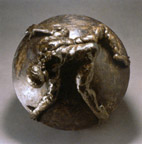 Tension is one of the most distinct and Powerful works featured in the 1972 exposition; its tenor, however, requires modifying the overwhelming sense of lightheartedness and gaiety with which Sharp and Wai Hon characterised the productions in that show. Tension symbolises struggle and pain in situations that are uncertain and changing. The dominant formal unit is a rounded shape which also has a function as a base. The surface at the top of this portion is curved and swollen. Surmounting it is a nude, male figure lying on its abdomen and spread-eagled to cover the entire Summit. It grasps, clutches the edges of the form and its surface with its entire body, endeavouring to secure a perch. The composition can be rolled and swivelled on its own internal axis. The movements, initiated by the spectator, agitate the scheme, threatening to dislodge the figure. In anticipation, the body of the figure is contorted into knotty, bunched clusters of muscles and tendons, as it glues itself to the supporting form.
Tension is one of the most distinct and Powerful works featured in the 1972 exposition; its tenor, however, requires modifying the overwhelming sense of lightheartedness and gaiety with which Sharp and Wai Hon characterised the productions in that show. Tension symbolises struggle and pain in situations that are uncertain and changing. The dominant formal unit is a rounded shape which also has a function as a base. The surface at the top of this portion is curved and swollen. Surmounting it is a nude, male figure lying on its abdomen and spread-eagled to cover the entire Summit. It grasps, clutches the edges of the form and its surface with its entire body, endeavouring to secure a perch. The composition can be rolled and swivelled on its own internal axis. The movements, initiated by the spectator, agitate the scheme, threatening to dislodge the figure. In anticipation, the body of the figure is contorted into knotty, bunched clusters of muscles and tendons, as it glues itself to the supporting form.
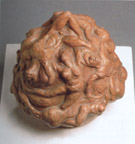 The relationship between bodies and space assumes complex configurations in this work; kinetic properties are actualised and may be experienced directly. While the relationship is given dramatic expression in Tension, the formal and symbolic interests exemplified in it are not new. For instance in Tragedy of War I, which was produced in 1966 (Fig. 109), figures are wrapped around and over a conical form, seen caught in an eddying movement which will never cease. In this work too, Eng Teng accentuates consequences on figures subjected to extreme physical and psychological stress. Presented in high and low relief they enact movements which are forceful and compelling; yet, they are implied. In Tension, movement is actualised and the connection between body and space is immediate.
The relationship between bodies and space assumes complex configurations in this work; kinetic properties are actualised and may be experienced directly. While the relationship is given dramatic expression in Tension, the formal and symbolic interests exemplified in it are not new. For instance in Tragedy of War I, which was produced in 1966 (Fig. 109), figures are wrapped around and over a conical form, seen caught in an eddying movement which will never cease. In this work too, Eng Teng accentuates consequences on figures subjected to extreme physical and psychological stress. Presented in high and low relief they enact movements which are forceful and compelling; yet, they are implied. In Tension, movement is actualised and the connection between body and space is immediate.
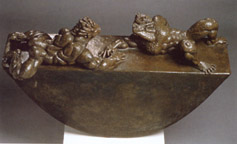 In pursuing these concerns over a period of time, paths of continuity can be mapped; in this respect Survival, 1973 (Fig. 110) can be viewed as furthering the presentation of figures under stress in increasingly mobile circumstances. Two male figures approach one another from opposite ends of a platform; their bodies have been entirely deformed by their exertions. It is not clear if their encounter promises collaboration or hints at competition; the uncertainty adds to the dramatic tenor of the content. The platform slopes downwards steeply and meets the ground as a continuous curve. As it is rocked, the figures are, in turn, elevated and depressed at the behest of the viewers' intervention. Their destinations appear to be determined by the fortuitous intercession of unknown forces.
In pursuing these concerns over a period of time, paths of continuity can be mapped; in this respect Survival, 1973 (Fig. 110) can be viewed as furthering the presentation of figures under stress in increasingly mobile circumstances. Two male figures approach one another from opposite ends of a platform; their bodies have been entirely deformed by their exertions. It is not clear if their encounter promises collaboration or hints at competition; the uncertainty adds to the dramatic tenor of the content. The platform slopes downwards steeply and meets the ground as a continuous curve. As it is rocked, the figures are, in turn, elevated and depressed at the behest of the viewers' intervention. Their destinations appear to be determined by the fortuitous intercession of unknown forces.
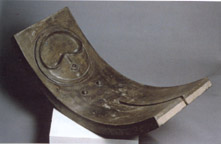 When Eng Teng shifts his attention away from dramatic expressions of trauma and anxiety to dealing with predominantly formal matters, the outcome is markedly different. In such schemes, the figure is absorbed into or immersed in the dominant formal concerns or forces. Compared with the works discussed above, these are tranquil, displaying states of harmony and equilibrium; unlike the compositions featured earlier, these offer oases for contemplation and quiet reflection. Flat Torso, 1971 (Fig. 111) and Torso (Rocker), 1973 (Fig. 112) are exemplary realisations of such aims.
When Eng Teng shifts his attention away from dramatic expressions of trauma and anxiety to dealing with predominantly formal matters, the outcome is markedly different. In such schemes, the figure is absorbed into or immersed in the dominant formal concerns or forces. Compared with the works discussed above, these are tranquil, displaying states of harmony and equilibrium; unlike the compositions featured earlier, these offer oases for contemplation and quiet reflection. Flat Torso, 1971 (Fig. 111) and Torso (Rocker), 1973 (Fig. 112) are exemplary realisations of such aims. 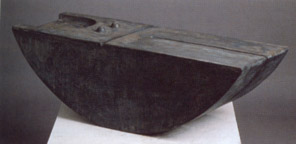 A drawing executed at about this time displays a number of schemes dealing with mobiles featuring curved forms and shapes (Fig. 113); it is evident that the prospects are fertile and extensive. In Flat Torso and Torso (Rocker) appear in this collection of drawn images as completely conceptualised. the figure is inscribed as a schematic arrangement with its features and physiognomy abbreviated, even suppressed. Eng Teng submitted this work as part of his entries for the first national sculpture exposition in 1976; in reviewing his submissions for this show, Tow Theow-Huang singles it out for special mention and declares his partiality towards it:
A drawing executed at about this time displays a number of schemes dealing with mobiles featuring curved forms and shapes (Fig. 113); it is evident that the prospects are fertile and extensive. In Flat Torso and Torso (Rocker) appear in this collection of drawn images as completely conceptualised. the figure is inscribed as a schematic arrangement with its features and physiognomy abbreviated, even suppressed. Eng Teng submitted this work as part of his entries for the first national sculpture exposition in 1976; in reviewing his submissions for this show, Tow Theow-Huang singles it out for special mention and declares his partiality towards it:
My favourite work is the coot and seductive Flat Torso. The full and spherical shape of Eve has given way to athin rectangular wafer, again gracefully cursed like a shallow U. A circle represents the stylised head, two nipples the breast, and a cut at the other end of the wafer divides it into two legs. In this work minimal but more than adequate reference to subject matter is pleasingly acheived while the essential geometric.
(Tow Theow-Huang, 'Sculptures that rock and roll', in New Nation, November 26, 1991.)
It is interesting to note the effort expended by Tow in distinguishing representationality from the purely design aspects of the composition; the operation is a delicate one. The description underlines the subtle relationship forged between the figure as such and the geometry of the composition. An interconnection of comparable sophistication is visible in Torso (Rocker). If anything, the integration of the figure into the design is comprehensive, so much so it has surrendered all semblance of distinctiveness. The figure is incorporated into the dynamics of design; its connection with space is subsumed or determined by those dynamics.
In accounting for the new sculptures in the 1972 exposition, Wai Hon rightly emphasises Eng Teng's preference for working in a connected manner; "He works in series. This gives him a chance to explore his subject in depth. His latest series is a direct result of what went on before." (Ng Eng Teng's New Image) One of the aims of this study has been to analyse such trajectories. To Wai Hon's description must be added a caveat, namely: in as much as Eng Teng's methodology involves producing a number of works dealing with a particular issue or problem, thereby constituting a series over periods of time, this progression is not in one direction alone. He is likely to return to earlier commitments, revitalising them with his most recent advancements.
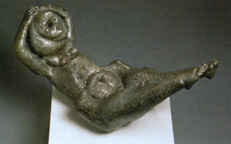 This tendency is vividly demonstrated in Sunbather, 1974 (Fig. 114) and Fallen, 1982 (Fig. 115). Whereas in the two earlier works the figure is a discreet component in the design, in these two it asserts its representational presence and concreteness. Both compositions are designed as curves; but unlike Flat Torso and Torso (Rocker), they are not mobile. The design elements from these mobile schemes have been transferred and consolidated as attributes of the figure. Fallen is a complex work; the legs are interlocked the upper limbs are summarised as stumps and then folded backwards. The head is treated as an indeterminate, demonic entity. The thighs and torso are rendered as powerful, scarred, slab-like planes, the head and shoulders contour, shape the space around the upper section of the figure.
This tendency is vividly demonstrated in Sunbather, 1974 (Fig. 114) and Fallen, 1982 (Fig. 115). Whereas in the two earlier works the figure is a discreet component in the design, in these two it asserts its representational presence and concreteness. Both compositions are designed as curves; but unlike Flat Torso and Torso (Rocker), they are not mobile. The design elements from these mobile schemes have been transferred and consolidated as attributes of the figure. Fallen is a complex work; the legs are interlocked the upper limbs are summarised as stumps and then folded backwards. The head is treated as an indeterminate, demonic entity. The thighs and torso are rendered as powerful, scarred, slab-like planes, the head and shoulders contour, shape the space around the upper section of the figure.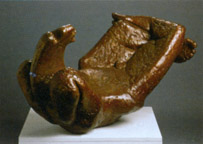 The planar arrangements in the lower limbs and abdomen give way to assertive volumes in the upper sections. These transitions and their passage from one end to the other bring into prominence depth and surface properties; in these ways the relationship of the figure as a sculpted entity to its environment is crystallised. It is a forceful presentation of the state of dispossession and the expression of that predicament. By placing it on the floor Eng Teng subjects the figure to the comprehensive, commanding gaze of the viewer; indeed, the spectator is empowered to read and possess the image variously and at will.
The planar arrangements in the lower limbs and abdomen give way to assertive volumes in the upper sections. These transitions and their passage from one end to the other bring into prominence depth and surface properties; in these ways the relationship of the figure as a sculpted entity to its environment is crystallised. It is a forceful presentation of the state of dispossession and the expression of that predicament. By placing it on the floor Eng Teng subjects the figure to the comprehensive, commanding gaze of the viewer; indeed, the spectator is empowered to read and possess the image variously and at will.
In considering the new works displayed in the 1972 exhibition Wai Hon remarks that "The sculpture of Eng Teng belongs not to just one segment of our society but to all." (Ibid.) It is tempting to connect this opinion with the pattern of observations made above; it was, however, prompted by viewing works categorised as "rocking faces" which were featured in that exposition. These were composed of the "head with an upturned face. The features are simplified almost to abstraction, and colour is added to give it an air of gaiety. (Ibid.) Eng Teng focuses on the head and converts it into mobile entities. The head appeared early in his sculptural practice, chiefly devoted to portraiture; now its format and scope is expanded considerably. Indeed, the head as a sculptural motif appears with immense possibilities; it is featured in a wide range of contexts, at times mirthful or playful, and at other times with serious symbolic import.
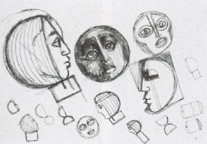
 In drawings such as Face Forms for Sculpture, c. 1971 (Fig. 116) and Study for Mobiles and Rockers, c. 1971 (Fig. 117), these aims are seen at their initial stages of formation. In the former, the face is presented in profile and frontally; it is also attached to geometric shapes. Steps are taken to simplify facial features, omitting details and rendering arrangements in which the abbreviated face and the silhouettes of circles and semi-circles begin to fuse, In the latter the face recedes; design and linear patterns gain prominence. In one sketch the figure is schematised and absorbed into a purely geometric configuration. Explorations such as these are the basis of an array of figurative and non-figurative compositions produced in ciment fondu and clay.
In drawings such as Face Forms for Sculpture, c. 1971 (Fig. 116) and Study for Mobiles and Rockers, c. 1971 (Fig. 117), these aims are seen at their initial stages of formation. In the former, the face is presented in profile and frontally; it is also attached to geometric shapes. Steps are taken to simplify facial features, omitting details and rendering arrangements in which the abbreviated face and the silhouettes of circles and semi-circles begin to fuse, In the latter the face recedes; design and linear patterns gain prominence. In one sketch the figure is schematised and absorbed into a purely geometric configuration. Explorations such as these are the basis of an array of figurative and non-figurative compositions produced in ciment fondu and clay.
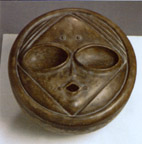
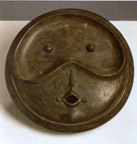 Sunken Head, c. 1972 (Fig. 118) and Flat Head, c. 1972 (Fig. 119) are realisations of schemes initially studied in drawings. In Sunken Head, the eyes have been scooped out, leaving pools of curved recessed spaces; the mouth is reduced and pouts, allowing entry into the form, indicating interior space and volume. The hair is reduced to three straight raised lines, while the eyebrows are summarised by two dots in relief. The face is contoured by a rhomboid frame and then set in a circle which is distinguished from the edge of the mobile proper. The grouping of shapes and lines as well as the articulation of the surface generate varied, yet coherent relationships between surface and depth properties. Similar effects are visible in Flat Head, although the design components are sparingly employed.
Sunken Head, c. 1972 (Fig. 118) and Flat Head, c. 1972 (Fig. 119) are realisations of schemes initially studied in drawings. In Sunken Head, the eyes have been scooped out, leaving pools of curved recessed spaces; the mouth is reduced and pouts, allowing entry into the form, indicating interior space and volume. The hair is reduced to three straight raised lines, while the eyebrows are summarised by two dots in relief. The face is contoured by a rhomboid frame and then set in a circle which is distinguished from the edge of the mobile proper. The grouping of shapes and lines as well as the articulation of the surface generate varied, yet coherent relationships between surface and depth properties. Similar effects are visible in Flat Head, although the design components are sparingly employed.
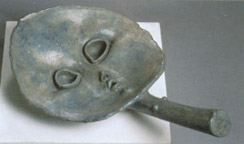 The head as a motif is prospected enthusiastically and with sustained creative vigour. In doing so Eng Teng not only increases the domain of formal aspects, but enriches symbolic dimensions or, as Sheares remarks, enhances "metaphorical meaning," (Poetic Metaphors: Sculptures of Ng Eng Teng) Blue Violet, 1973 (Fig. 120)
The head as a motif is prospected enthusiastically and with sustained creative vigour. In doing so Eng Teng not only increases the domain of formal aspects, but enriches symbolic dimensions or, as Sheares remarks, enhances "metaphorical meaning," (Poetic Metaphors: Sculptures of Ng Eng Teng) Blue Violet, 1973 (Fig. 120)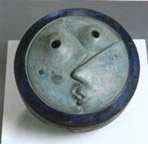 displays fusion of floral and human characteristics. Vestiges of the face are transformed into adopting the disposition of a leaf of the African Violet. Sometimes two heads are featured, stimulating grounds for interrelationships. Lovers II, 1974 (Fig. 121) exemplifies the most intimate and optimistic consequences of physical proximity, Two faces are intertwined, engaged in a deep, abiding kiss; when the mobile is agitated, the immersion of one in the other is deepened and erotically enlivened. In Head, 1990 (Fig. 122) and Centre Hair Parting, 1992 (Fig. 123) the head is imbued with a hieratic mien and presence. These are impressive creations, drawing the viewer towards them in attitudes of prolonged contemplation.
displays fusion of floral and human characteristics. Vestiges of the face are transformed into adopting the disposition of a leaf of the African Violet. Sometimes two heads are featured, stimulating grounds for interrelationships. Lovers II, 1974 (Fig. 121) exemplifies the most intimate and optimistic consequences of physical proximity, Two faces are intertwined, engaged in a deep, abiding kiss; when the mobile is agitated, the immersion of one in the other is deepened and erotically enlivened. In Head, 1990 (Fig. 122) and Centre Hair Parting, 1992 (Fig. 123) the head is imbued with a hieratic mien and presence. These are impressive creations, drawing the viewer towards them in attitudes of prolonged contemplation.
 There are two compositions in this collection in which the head is conceptualised in incomparably innovative and audacious ways; they can, for these reasons, be seen as marking climactic moments in the development of this motif in Eng Teng's sculptural oeuvre. At the very beginning of his practice, the head was principally employed in terms of portraiture; not surprisingly, the chief concerns in them were in registering psychological resonances and particularities of an individual identity and presence. The dominant aims in the creation of the mobiles and rockers were to explore,
There are two compositions in this collection in which the head is conceptualised in incomparably innovative and audacious ways; they can, for these reasons, be seen as marking climactic moments in the development of this motif in Eng Teng's sculptural oeuvre. At the very beginning of his practice, the head was principally employed in terms of portraiture; not surprisingly, the chief concerns in them were in registering psychological resonances and particularities of an individual identity and presence. The dominant aims in the creation of the mobiles and rockers were to explore,
 extend the formal parameters of sculpture, especially regarding its kinetic properties; in these compositions the head was depsychologised. Red Face, 1986 (Fig. 124) completely upturns all expectations regarding the formal presentation of the head and the conveyance of symbolic meaning. In reversing the customary appearance Eng Teng is denying the head its pre-eminence; it is not the repository of identity and neither is it the centre of a psychological being. In embarking on this pathway, Eng Teng is reconsidering the function, role and purpose of the head in art, including its appearance in his own art; needless to say, we are also engaged in these procedures of reconsideration.
extend the formal parameters of sculpture, especially regarding its kinetic properties; in these compositions the head was depsychologised. Red Face, 1986 (Fig. 124) completely upturns all expectations regarding the formal presentation of the head and the conveyance of symbolic meaning. In reversing the customary appearance Eng Teng is denying the head its pre-eminence; it is not the repository of identity and neither is it the centre of a psychological being. In embarking on this pathway, Eng Teng is reconsidering the function, role and purpose of the head in art, including its appearance in his own art; needless to say, we are also engaged in these procedures of reconsideration.
The features of Red Face are exaggerated, approximating the configuration of a mask. The pouting lips, perforated nostrils and deeply set eyeballs lead to the apprehension of interior spaces and volumes. The surface is articulated vigorously, even dramatically; as a result planes curve and rise steeply, generating deep spaces within the form. The surface is marked by sharp, irregular cuts; these enliven the textural characteristics of the exterior planes. The form is painted in red, a colour that radiates light forcefully. This is a strident composition, exerting a powerful, commanding presence; in it the head is transformed into an evocative sculptural entity, capable of sustaining close viewing at the conceptual and formal levels.(Elsen, p. 49-52.)
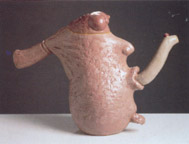 The second of the two compositions in which the head can be seen as assuming an audacious exposition is "Head" Teapot, 1992 (Fig. 125). Its handle is represented by a tuft of tightly bound hair; the spout is converted into a mouth from which extends an extraordinarily long tongue which supports a ladybird at its very tip. The cover is shaped as two bulging eyes which can also be read as breasts with extended nipples. The contours of the teapot conform to the profile of a head; the nose is included in order to complete the profile although it does not correspond to any functional component of the vessel. With regard to the treatment of the bead, this work displays a heightened degree of wit bordering on the caricature. In the context of his studio pottery practice it marks an overt anthropomorphic transformation of the vessel. In dealing with the cover, it was described as eyes which could also be read as breasts. The ambiguity is deliberate and is one of the sustaining forces in determining the content as well as the form of sculptures produced in the mid 1990s until the Present.
The second of the two compositions in which the head can be seen as assuming an audacious exposition is "Head" Teapot, 1992 (Fig. 125). Its handle is represented by a tuft of tightly bound hair; the spout is converted into a mouth from which extends an extraordinarily long tongue which supports a ladybird at its very tip. The cover is shaped as two bulging eyes which can also be read as breasts with extended nipples. The contours of the teapot conform to the profile of a head; the nose is included in order to complete the profile although it does not correspond to any functional component of the vessel. With regard to the treatment of the bead, this work displays a heightened degree of wit bordering on the caricature. In the context of his studio pottery practice it marks an overt anthropomorphic transformation of the vessel. In dealing with the cover, it was described as eyes which could also be read as breasts. The ambiguity is deliberate and is one of the sustaining forces in determining the content as well as the form of sculptures produced in the mid 1990s until the Present.
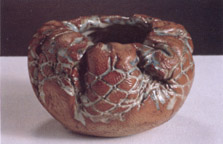 Eng Teng pursues dual interests in sculpture and studio pottery, concurrently. When productions from the two media are compared, sculptures dominate on account of their rich and diverse iconography as well as their assertive, formal presentations in actual space. Still, important advances are made in pottery; in this regard, Eng Teng's ceramic practice deserves detailed, independent study, in which methods and technologies are examined. For the present attention is drawn to a few vessels, selected at random, to highlight degrees to which the vessel is modified or, to use Eng Teng's graphic description of his purpose, "tortured"
Eng Teng pursues dual interests in sculpture and studio pottery, concurrently. When productions from the two media are compared, sculptures dominate on account of their rich and diverse iconography as well as their assertive, formal presentations in actual space. Still, important advances are made in pottery; in this regard, Eng Teng's ceramic practice deserves detailed, independent study, in which methods and technologies are examined. For the present attention is drawn to a few vessels, selected at random, to highlight degrees to which the vessel is modified or, to use Eng Teng's graphic description of his purpose, "tortured"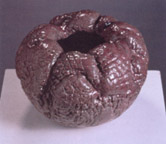 in order to register distinctiveness and to imprint the production with a sense of individuality. Instant Folded Pot I, 1987 (Fig. 126) is an entity that appears to be the outcome of molten material which has cooled and settled into an arbitrary form, rather than a deliberately designed product. It is a bowl whose walls are irregular, rough and heavily textured; even, curvaceous planes, aligned symmetrically have been replaced by asymmetry and happenstance. The mouth is like a crater, leading into a cavernous interior space; the walls are scarred with deep, jagged fissures. Although it is functional, its abiding appeal is aesthetic, and of a particular or partial disposition. Similar characteristics are visible in Instant Folded Pot II, c. 1987 (Fig. 127).
in order to register distinctiveness and to imprint the production with a sense of individuality. Instant Folded Pot I, 1987 (Fig. 126) is an entity that appears to be the outcome of molten material which has cooled and settled into an arbitrary form, rather than a deliberately designed product. It is a bowl whose walls are irregular, rough and heavily textured; even, curvaceous planes, aligned symmetrically have been replaced by asymmetry and happenstance. The mouth is like a crater, leading into a cavernous interior space; the walls are scarred with deep, jagged fissures. Although it is functional, its abiding appeal is aesthetic, and of a particular or partial disposition. Similar characteristics are visible in Instant Folded Pot II, c. 1987 (Fig. 127).
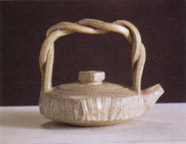 In pursuing novelty, studio-potters willingly by-pass functional requirements; this is one way of approaching the situation. Another would be to admit that function is respected but that it competes with formal concerns and engagements; consequently, in appraising the ensuing vessel, there is near unanimity in foregoing its utility and cherishing it for its aesthetic values. If this situation can be adopted as constituting a dilemma, then one is dealing with it when encountering Tea Pot I (Twin Handled), undated (Fig. 128). The general expectations of such a vessel are swept aside; instead there appears a vessel of immense formal complexity projecting an equally immense monumental presence. The body, spout, the lid and its knob are realised in terms of articulated planes which merge subtly; the handle is powerfully modelled, and forcefully defines the spatial environment. These are attributes of sculpture.
In pursuing novelty, studio-potters willingly by-pass functional requirements; this is one way of approaching the situation. Another would be to admit that function is respected but that it competes with formal concerns and engagements; consequently, in appraising the ensuing vessel, there is near unanimity in foregoing its utility and cherishing it for its aesthetic values. If this situation can be adopted as constituting a dilemma, then one is dealing with it when encountering Tea Pot I (Twin Handled), undated (Fig. 128). The general expectations of such a vessel are swept aside; instead there appears a vessel of immense formal complexity projecting an equally immense monumental presence. The body, spout, the lid and its knob are realised in terms of articulated planes which merge subtly; the handle is powerfully modelled, and forcefully defines the spatial environment. These are attributes of sculpture.
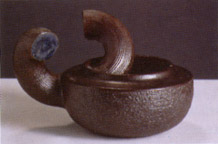 The relationship between pottery and sculpture in Eng Teng's practice has received continuous attention; writers mostly emphasise the influence of his pottery on the three-dimensional compositions. However the connection may be defined and analysed, it is not just one way. That is to say, in his endeavour to expand the creative basis of his pottery, Eng Teng transfers to it formal units developed in his sculptural practice; in doing so be advances its aesthetic dimension. In doing so too, one has to deal with the dilemma as explained above. In Donut Ashtray, undated (Fig. 129), a handle is attached to a vessel which customarily does not have such an appendage. Eng Teng has done so for visual effect and enhancement. There is an additional remark to be made; the form of the handle is derived from a series of sculptures which he produced in 1972 in which the dominant forms were tubular. The schemes cultivated within the parameters of a particular medium are now conceptualised as formal vocabularies which are flexible, adaptable for use in circumstances other than their original grounds. Eng Teng has developed a visual language which he employs when negotiating connections between one medium and another; this is done not to minimise differences between media but to breach conventions that define them, thereby extending their scope and redefining them.
The relationship between pottery and sculpture in Eng Teng's practice has received continuous attention; writers mostly emphasise the influence of his pottery on the three-dimensional compositions. However the connection may be defined and analysed, it is not just one way. That is to say, in his endeavour to expand the creative basis of his pottery, Eng Teng transfers to it formal units developed in his sculptural practice; in doing so be advances its aesthetic dimension. In doing so too, one has to deal with the dilemma as explained above. In Donut Ashtray, undated (Fig. 129), a handle is attached to a vessel which customarily does not have such an appendage. Eng Teng has done so for visual effect and enhancement. There is an additional remark to be made; the form of the handle is derived from a series of sculptures which he produced in 1972 in which the dominant forms were tubular. The schemes cultivated within the parameters of a particular medium are now conceptualised as formal vocabularies which are flexible, adaptable for use in circumstances other than their original grounds. Eng Teng has developed a visual language which he employs when negotiating connections between one medium and another; this is done not to minimise differences between media but to breach conventions that define them, thereby extending their scope and redefining them.
When Eng Teng began developing his practice on his return in 1966, which was consolidated in 1970 leading to his first solo exhibition, involvement with painting declined; in fact it almost disappeared from his range of interests. However, pictures were produced intermittently, chiefly to cater for intensely private needs and purposes. Even as theses are isolated, infrequent creations, they are connected with earlier efforts in the early 1960, when painting was an important activity.
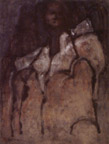 Wild Rover, c. 1970 (Fig. 130) is of particular interest; it is a self portrait. The attributed date places it at the time when he was trying to establish his practice. His return, while avidly desired, was not easy and the circumstances that prevailed have been described.
Wild Rover, c. 1970 (Fig. 130) is of particular interest; it is a self portrait. The attributed date places it at the time when he was trying to establish his practice. His return, while avidly desired, was not easy and the circumstances that prevailed have been described.  The image may well be prompted by the uncertainty, anxiety surrounding his attempts to secure a foothold for his creative activities. Only the head appears discernibly, and then it is positioned at a distance, remote and inaccessible. The remaining portions of the figure are indistinct, shown as disappearing in an imaginary landscape. The outlined forms, contoured by thick black lines, are comparable to those which were used in So Very Cold (Fig. 82), although they are employed economically in this composition. The image conveys a sense of fragmentation which symbolises the deep disquiet or unease experienced by Eng Teng on his return and arising from difficulties encountered in establishing his practice.
The image may well be prompted by the uncertainty, anxiety surrounding his attempts to secure a foothold for his creative activities. Only the head appears discernibly, and then it is positioned at a distance, remote and inaccessible. The remaining portions of the figure are indistinct, shown as disappearing in an imaginary landscape. The outlined forms, contoured by thick black lines, are comparable to those which were used in So Very Cold (Fig. 82), although they are employed economically in this composition. The image conveys a sense of fragmentation which symbolises the deep disquiet or unease experienced by Eng Teng on his return and arising from difficulties encountered in establishing his practice.
If there is one theme which is associated with Eng Teng it is that featuring the mother with the child; indeed, in the public's regard, his sculptural world and this subject are synonymous. Such a view underlines the esteem of this theme and the deep emotional and psychological bonds uniting viewers with expressions of it. The interest in this subject is fuelled by a number of sources. Firstly, there is Eng Teng's affiliation with his family, the abiding kinship with his parents as well as his brothers and sisters and beyond. These connections are subjects of his paintings and sculptures, through which he defines the extent and nature of relationships. Secondly, in turning to his environment he repeatedly encountered the presence of children in the adult world; they were not excluded, Rather, they were integrated in the adult realms of work, leisure and the performance of rituals. Thirdly, there is the world of art in which the mother and child is manifested in numerous ways and in varied circumstances; no doubt, the development of this theme by Henry Moore proved to be highly influential internationally. Eng Teng responded to it enthusiastically and with discrimination.
In this collection there are numerous productions featuring this subject; they are executed in a number of media and present different approaches. Indeed, the material is sufficiently rich and the compositions markedly diverse to merit independent expositions and detailed critical explications. While the mother and child are the chief components in these manifestations, they are by no means the only ones; occasionally there are representations that include the father; occasionally too, there arc depictions of mother, father and child.

 The themes of mother and child and the family surfaced in the 1960s, and gained momentum between 1968-69. Mother and Child I, c.1969 (Fig.131) and Mother and Child II, c.1969 (Fig. 132) are drawings in which the relationship between the two is depicted as intimate and interdependent. In the former, the mother stands, holding the child on her left with one arm to support its weight and the other to secure it in place. As formal units the two are integrated harmoniously. In the latter, the mother is seated; the child is wrapped in its own clothing and held tenderly but tightly close to her breasts. Eng Teng provides considerable detail in order to convey expression and identity. The features of the mother are drawn tenderly while those of the child appear content and secure. The drapery of the mother is depicted as a continuous shape enveloping the two forms comfortably. In Studies for Family Group and Mother and Child, c.1969 (Fig.133) and Studies for "Mother and Child", 1969
The themes of mother and child and the family surfaced in the 1960s, and gained momentum between 1968-69. Mother and Child I, c.1969 (Fig.131) and Mother and Child II, c.1969 (Fig. 132) are drawings in which the relationship between the two is depicted as intimate and interdependent. In the former, the mother stands, holding the child on her left with one arm to support its weight and the other to secure it in place. As formal units the two are integrated harmoniously. In the latter, the mother is seated; the child is wrapped in its own clothing and held tenderly but tightly close to her breasts. Eng Teng provides considerable detail in order to convey expression and identity. The features of the mother are drawn tenderly while those of the child appear content and secure. The drapery of the mother is depicted as a continuous shape enveloping the two forms comfortably. In Studies for Family Group and Mother and Child, c.1969 (Fig.133) and Studies for "Mother and Child", 1969 
 (Fig.134), Eng Teng reduces the scope of representational data, electing to condense visual details into shapes that can be realised in three-dimensional forms. The transition is especially compelling and revealing in the latter when the two sketches are compared. A study titled Father and Child, c.1979 (Fig.135) does not display facility and resolution comparable to the drawing considered earlier. The proportion of the two figures is awkward as are the positioning of the child and the gesture of the two figures. Towards the top right corner Eng Teng develops the scheme, reducing details and gradually reaching towards forms that are settled and stable.
(Fig.134), Eng Teng reduces the scope of representational data, electing to condense visual details into shapes that can be realised in three-dimensional forms. The transition is especially compelling and revealing in the latter when the two sketches are compared. A study titled Father and Child, c.1979 (Fig.135) does not display facility and resolution comparable to the drawing considered earlier. The proportion of the two figures is awkward as are the positioning of the child and the gesture of the two figures. Towards the top right corner Eng Teng develops the scheme, reducing details and gradually reaching towards forms that are settled and stable.

 These drawings are, at times, translated into three dimensional figures. Pride of a Mother, 1978 (Fig. 136), for instance, is an outgrowth from the drawing illustrated in Fig. 131; here the figures are provided with detailed facial features. The lower limbs of the mother and the tightly wrapped child echo one another in formal design; for that matter, patterns of rhythm integrate the two figures and articulate the relationships of bodies and space. Nonya Mother,
These drawings are, at times, translated into three dimensional figures. Pride of a Mother, 1978 (Fig. 136), for instance, is an outgrowth from the drawing illustrated in Fig. 131; here the figures are provided with detailed facial features. The lower limbs of the mother and the tightly wrapped child echo one another in formal design; for that matter, patterns of rhythm integrate the two figures and articulate the relationships of bodies and space. Nonya Mother,  1978 (Fig. 137) is an energetic, cheerful representation. It is also an exemplary realisation of movement. The undulating hem of the mother's drapery generates a series of rhythmic movements which animates the entire figure and the space around it; it also infects the disposition of the child, who holds its head upright and alert. The patterns of ornament on the fabric of the drapery underscores the complexity of the movements swelling from the striding figure. The hair is swept backwards and waves in the wind, enhancing the kinetic tenor of the image. In these two compositions, Eng Teng has studied the formal vocabulary of Epstein and adapted it to his purposes; symptoms of the influence are discernible in the depiction of the hair and the simplification of the upper limbs into cylindrical forms
1978 (Fig. 137) is an energetic, cheerful representation. It is also an exemplary realisation of movement. The undulating hem of the mother's drapery generates a series of rhythmic movements which animates the entire figure and the space around it; it also infects the disposition of the child, who holds its head upright and alert. The patterns of ornament on the fabric of the drapery underscores the complexity of the movements swelling from the striding figure. The hair is swept backwards and waves in the wind, enhancing the kinetic tenor of the image. In these two compositions, Eng Teng has studied the formal vocabulary of Epstein and adapted it to his purposes; symptoms of the influence are discernible in the depiction of the hair and the simplification of the upper limbs into cylindrical forms
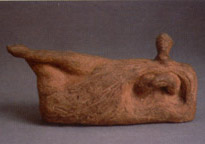 Maquettes are three-dimensional preparatory studies undertaken with the prospect of realising them in a completed or finalised composition. In this collection there is an extensive array of such studies; some have been transformed into finished works, The majority has not. These maquettes are important in that they provide valuable insights into conceptual and formal interests in Eng Teng's oeuvre and their development over a period of time.
For instance, among the maquettes are relining figures which clearly illustrate his absorption of sculptural schemes created by Henry Moore. Reclining Form, undated (Fig.138) is an unambiguous adoption of the design of the reclining female figure immortalised by Moore. Eng Teng finds it appealing and appropriates it uninhibitedly.
Maquettes are three-dimensional preparatory studies undertaken with the prospect of realising them in a completed or finalised composition. In this collection there is an extensive array of such studies; some have been transformed into finished works, The majority has not. These maquettes are important in that they provide valuable insights into conceptual and formal interests in Eng Teng's oeuvre and their development over a period of time.
For instance, among the maquettes are relining figures which clearly illustrate his absorption of sculptural schemes created by Henry Moore. Reclining Form, undated (Fig.138) is an unambiguous adoption of the design of the reclining female figure immortalised by Moore. Eng Teng finds it appealing and appropriates it uninhibitedly.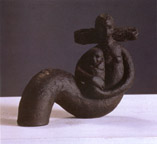
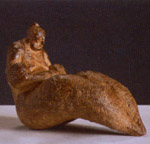 He is not content to remain with the concept as it is received; he extends, interprets and transforms it, imbuing it with purposes and identities that are unique. For instance, Reclining Form leads him to Tubular Mother and Child, undated (Fig. 140), and to the crystallisation of the mother and child theme. Throughout the 1970s the mother and child subject is studied methodically; compositional schemes are explored and settled upon; by the end of the decade a connected series of work is produced, bearing distinct formal presences and converging subtle symbolic resonances.
He is not content to remain with the concept as it is received; he extends, interprets and transforms it, imbuing it with purposes and identities that are unique. For instance, Reclining Form leads him to Tubular Mother and Child, undated (Fig. 140), and to the crystallisation of the mother and child theme. Throughout the 1970s the mother and child subject is studied methodically; compositional schemes are explored and settled upon; by the end of the decade a connected series of work is produced, bearing distinct formal presences and converging subtle symbolic resonances.
 Madonna and Child II, 1990 (Fig. 141) is the most austere exposition on the subject of mother and child; it conforms to the hicratic imposition of power, associated with and exercised by an icon. The Madonna is seated; her legs are crossed approximately in the manner in which icons of the Buddha and Hindu deities are presented. The drapery of her lower limbs, which is comparable to a sarong, swells out and is depicted as extended, curved forms with powerful interior volumes. Her large hands, which are abbreviated, hold the outstretched arms of the child. The torso of the Madonna is simplified into a flat plane which is amplified to accommodate her head. The curved forms below are contrasted with the angular shapes towards the top; these differences are underlined by the heads of the child and the Madonna which also are turned in opposing directions. This is a complex composition; the forms of the figures are articulated forcefully; they relate to one another and to the space around and within them in their ample, three-dimensional capacities.
Madonna and Child II, 1990 (Fig. 141) is the most austere exposition on the subject of mother and child; it conforms to the hicratic imposition of power, associated with and exercised by an icon. The Madonna is seated; her legs are crossed approximately in the manner in which icons of the Buddha and Hindu deities are presented. The drapery of her lower limbs, which is comparable to a sarong, swells out and is depicted as extended, curved forms with powerful interior volumes. Her large hands, which are abbreviated, hold the outstretched arms of the child. The torso of the Madonna is simplified into a flat plane which is amplified to accommodate her head. The curved forms below are contrasted with the angular shapes towards the top; these differences are underlined by the heads of the child and the Madonna which also are turned in opposing directions. This is a complex composition; the forms of the figures are articulated forcefully; they relate to one another and to the space around and within them in their ample, three-dimensional capacities.

 By contrast, Over Mother's Head, 1990 (Fig. 142 and 144) injects burnout, if not hilarity, into the treatment of the subject; the child is positioned precariously on her head, while .she holds her left hand over her face as if suppressing or masking an expression of astonishment. This composition is, like the preceding one, cast in bronze. It is preceded by a maquette bearing the same title and executed in the same year; it is modelled in clay and fired to the consistency of stoneware (Fig. 143). Cast in bronze, it is a faithful translation of the study. The properties related to Surface and depth relationship are vividly demonstrated; these are prominent in the disposition of the visible leg and its emergence from the drapery which curves around it in high relief. This arrangement reappears along the torso and over the hidden left leg.
By contrast, Over Mother's Head, 1990 (Fig. 142 and 144) injects burnout, if not hilarity, into the treatment of the subject; the child is positioned precariously on her head, while .she holds her left hand over her face as if suppressing or masking an expression of astonishment. This composition is, like the preceding one, cast in bronze. It is preceded by a maquette bearing the same title and executed in the same year; it is modelled in clay and fired to the consistency of stoneware (Fig. 143). Cast in bronze, it is a faithful translation of the study. The properties related to Surface and depth relationship are vividly demonstrated; these are prominent in the disposition of the visible leg and its emergence from the drapery which curves around it in high relief. This arrangement reappears along the torso and over the hidden left leg. These point to refined, yet dynamic realisations of relief conceptions; depth and surface relationships, which are among the cardinal precepts in three-dimensional and relief sculpture, are articulated fluently and purposefully. A raised band indicating folds of the drapery, turns around the surface inducing a reading of curved planes in space. The relationship between the child and mother is animated, interactive and has the prospect of unexpected surprises. When viewed from the rear (Fig. 144),
These point to refined, yet dynamic realisations of relief conceptions; depth and surface relationships, which are among the cardinal precepts in three-dimensional and relief sculpture, are articulated fluently and purposefully. A raised band indicating folds of the drapery, turns around the surface inducing a reading of curved planes in space. The relationship between the child and mother is animated, interactive and has the prospect of unexpected surprises. When viewed from the rear (Fig. 144),
 the upright back and head of the mother can be interpreted as a phallus; in maintaining this reading it is evident that the male has not only been incorporated into the scheme but fulfills the double function of being generative and supportive. The integration is subtle; the composition is the most evocative presentation of the tripartite status and kinship of the female, male and progeny. The composite power of the symbolic tenor of this composition is appreciated when it is compared with Parents and Child I, 1979 and II, undated (Figs. 145, 146); although there are aspects deserving attention and merit in these maquettes, conceptually they are prosaic when matched with Over the Mother's Head.
the upright back and head of the mother can be interpreted as a phallus; in maintaining this reading it is evident that the male has not only been incorporated into the scheme but fulfills the double function of being generative and supportive. The integration is subtle; the composition is the most evocative presentation of the tripartite status and kinship of the female, male and progeny. The composite power of the symbolic tenor of this composition is appreciated when it is compared with Parents and Child I, 1979 and II, undated (Figs. 145, 146); although there are aspects deserving attention and merit in these maquettes, conceptually they are prosaic when matched with Over the Mother's Head.
The child is shown with the father independently, even though the configuration is infrequent; in this collection there are two finished compositions and one maquette dealing with this subject. Eng Teng distinguishes this theme from the mother and child in this way:
After many years working on the mother and child theme I produced the first father and child, in early 1970, titled Chip Off the Old Block; why not? To me the father is as important as the mother. Mother figure is often more physical, more in contact with the child. A father is like a mountain overlooking the valley which is the child, very attentive, guiding and guarding from afar. From a distance, yes. Sometimes we see a father carrying a child, or a child sitting over his shoulder which a mother does not do. This to me is a father's way of guiding a child to be brave, looking ahead with confidence. Mother is generally more gentle and protective. (Conversation, p. 163.)
Eng Teng characterises the relationship by drawing from the orthodox construction of power relationships binding the family; accordingly, the father is the patriarch, the wellspring of authority, strength, bravery and vitality - all of which are promulgated as distinctively Yale. What is more, these attributes are manifested, effectively, from a distance.
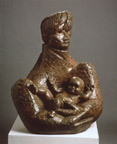 Father and Son, 1978 (Fig. 147) demonstrates two separate concerns; in one, the aim is to present an image of the father which corresponds with the traits described by Eng Teng. Hence the figure appears commanding; it looks into the distance, in the stereotypical posture used in public imagery for leaders and visionaries. In doing so it maintains a distance and is, therefore, aloof. In the other, the aim is to discard conventions and stereotypes, and present the child in a natural state; it is seen as active, moving its hands and legs vigorously. Even as the two have distinct characteristics, there is a sense of accommodation which permits bonding between them. This is demonstrated by the emcompassing gesture of the father; his arms are folded to provide space, to receive, accommodate the child comfortably. Eng Teng has amplified the arms in order to function effectively; the shoulder is disjointed as the upper arms rear up and swell out in order to make available a copious spatial ambience which can house the infant. The rounded form of the child fits snugly into the enclosed space defined by the encircling arms.
Father and Son, 1978 (Fig. 147) demonstrates two separate concerns; in one, the aim is to present an image of the father which corresponds with the traits described by Eng Teng. Hence the figure appears commanding; it looks into the distance, in the stereotypical posture used in public imagery for leaders and visionaries. In doing so it maintains a distance and is, therefore, aloof. In the other, the aim is to discard conventions and stereotypes, and present the child in a natural state; it is seen as active, moving its hands and legs vigorously. Even as the two have distinct characteristics, there is a sense of accommodation which permits bonding between them. This is demonstrated by the emcompassing gesture of the father; his arms are folded to provide space, to receive, accommodate the child comfortably. Eng Teng has amplified the arms in order to function effectively; the shoulder is disjointed as the upper arms rear up and swell out in order to make available a copious spatial ambience which can house the infant. The rounded form of the child fits snugly into the enclosed space defined by the encircling arms.
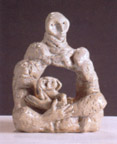 A bolder approach is adopted in the maquette, which bears the same title (Fig. 148) and is a study for the composition examined above. The torso of the father is hollowed out, leaving a cavity; the child, who is held in position by the hands of the father, is framed by this space which is an integral aspect of the design. Both father and child look at the viewer, displaying kinship in their appearance and in the mutuality of their rclationship. The figure of the father is modelled vigorously; the strength is conveyed in evoking a sense of protection or guardianship, rather than symbolising authority and dominance. The gestures and the figure of the child are tentative and remain rudimentary, In developing the subject from the maquette phase towards the finished scheme, Eng Teng elects to emphasise protocol; consequently, the figure of the father congeals into a formal declaration of status and power.
A bolder approach is adopted in the maquette, which bears the same title (Fig. 148) and is a study for the composition examined above. The torso of the father is hollowed out, leaving a cavity; the child, who is held in position by the hands of the father, is framed by this space which is an integral aspect of the design. Both father and child look at the viewer, displaying kinship in their appearance and in the mutuality of their rclationship. The figure of the father is modelled vigorously; the strength is conveyed in evoking a sense of protection or guardianship, rather than symbolising authority and dominance. The gestures and the figure of the child are tentative and remain rudimentary, In developing the subject from the maquette phase towards the finished scheme, Eng Teng elects to emphasise protocol; consequently, the figure of the father congeals into a formal declaration of status and power.
 Responsibility II, 1995 (Fig. 149) embodies the father and child theme; the child sits on the neck of the father. It rests its chin on its hands which are folded and crossed on the head of the father. The father's hands, which are magnified and severed from the rest of the body, hover over the child's legs, steadying them. The faces of the father and child are similar; they are modelled expressively, conveying determination and anguish. In 1969 Eng Teng produced a work also titled Responsibility (Fig. 96) in which the chief interest was in capturing kinetic effects, it was a device employed to symbolise the nature of responsibility as a maelstrom which absorbs one in an unending circuit of demand and labour. In this composition the theme is specified and made concrete in physical terms. The exertions by the father are transmitted to the child, who appears to be sharing the effort or its consequences. The body of the father is reduced to a scarred, partial entity; Eng Teng depicts it to look like a boulder or slab of rock, eroded but still resilient, The hands are enigmatic. Whose are they? Can they signal the intervention of unseen presence? Or are they the father's, now appearing disembodied and exuding power in order to ensure security and well-being? The hands connect the sculpted form with space in evocative ways; they can be read as compressing the space into and around the two figures. They can also be viewed as nudging the figures of the father and child into the expanded reaches of space, beyond the limits defined by the forms. Formally and symbolically this is a compelling work.
Responsibility II, 1995 (Fig. 149) embodies the father and child theme; the child sits on the neck of the father. It rests its chin on its hands which are folded and crossed on the head of the father. The father's hands, which are magnified and severed from the rest of the body, hover over the child's legs, steadying them. The faces of the father and child are similar; they are modelled expressively, conveying determination and anguish. In 1969 Eng Teng produced a work also titled Responsibility (Fig. 96) in which the chief interest was in capturing kinetic effects, it was a device employed to symbolise the nature of responsibility as a maelstrom which absorbs one in an unending circuit of demand and labour. In this composition the theme is specified and made concrete in physical terms. The exertions by the father are transmitted to the child, who appears to be sharing the effort or its consequences. The body of the father is reduced to a scarred, partial entity; Eng Teng depicts it to look like a boulder or slab of rock, eroded but still resilient, The hands are enigmatic. Whose are they? Can they signal the intervention of unseen presence? Or are they the father's, now appearing disembodied and exuding power in order to ensure security and well-being? The hands connect the sculpted form with space in evocative ways; they can be read as compressing the space into and around the two figures. They can also be viewed as nudging the figures of the father and child into the expanded reaches of space, beyond the limits defined by the forms. Formally and symbolically this is a compelling work.
Ma, Ge., A Brief History of Malayan Art, Nanyang Press, Singapore, 1963.
Read, H., A Concise History of Modern Sculpture, Thames and Hudson, London, 1964.
Trier, E., Form and Space. Sculpture of the Twentieth Century, Thames and Hudson, London, 1968.
Last updated: 11 January 2001